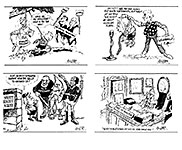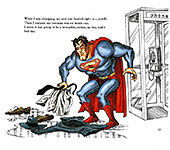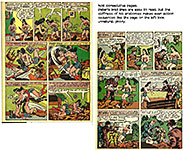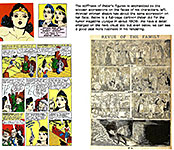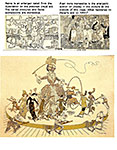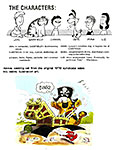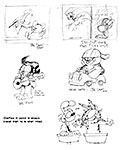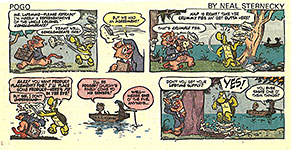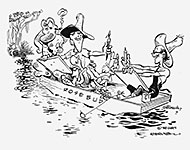 |
||||||||||||||
Opus 373 (November 18, 2017). Bounding up the bunny trail this time, we have reports on the November 2-4 meeting of editorial cartoonists, Wonder Woman Gadot’s stand on sexual harassment, a count of editorial cartoonists, and South Park’s failure to satirize Trump, an analysis of the so-called “cartoons” that have returned to Playboy, and reviews of two new Black comics resources and of three books reprinting the war years of Superman, Batman, and Wonder Woman and of a book on the Art of Garfield and the first issue of Batman White Knight, plus a count of editorial cartoonists, and “retired” editoonist Bill Sanders on Trump, Ed Stein on tax reform, Ted Rall’s suit, Hirschfeld biography held up. Here’s what’s here, in order, by department—:
CORRECTION Arv Miller not Art Paul changed Stag to Playboy Rabbit
NOUS R US Wonder Woman’s Gadot Takes a Stand Libyan Religions Fanatics Shut Down Comic Con Ted Rall’s Suit: Progress Report (Non-progress) Jeff Dahmer Movie Well Done Hirschfeld Biography Held Up Village Voice in Print Dies, Joining Others The Beat’s New Partner Colleen Doran’s Back South Park Avoids Trump Newspaper Comics Still Matter More About Guns KAL Gets Second Berryman Award, A First
EDITOONISTS TALK SHOP Report on the annual convention of the AAEC Joel Pett Gets AAEC’s Ink Bottle Award Dwane Powell Gets Babin Memorial Award Salt Lake City Con Appeals Gag Order and Wins
Odds & Addenda NCS Reuben 2018 in Philly Gasoline Alley Will Be 100 Next Year Disney Disciplined
CARTOONS BACK IN PLAYBOY But Not Very Good Ones
FUNNYBOOK FAN FARE Review of Batman White Knight No.1 EDITOONERY Looking at Last Month’s Crop
How Many of Us Are There? Counting Editorial Cartoonists
Bill Sanders Speaks Out
BOOK MARQUEE Short Reviews of—: Superman and the Miserable, Rotten, No Fun, Really Bad Day Superman: The War Years 1938-1945 Batman: The War Years 1939-1945 Wonder Woman: The War Years 1941-1945 The Art of Jim Davis’ Garfield Garfield Prank in Denver
BOOK REVIEWS Review and Critique of—: Encyclopedia of Black Comics Black Comics: Politics of Race and Representation
COLLECTORS’ CORNICHE My Name on the Skiff in Pogo
ONWARD, THE SPREADING PUNDITRY Ed Stein on Tax Reform
QUOTE OF THE MONTH If Not of A Lifetime “Goddamn it, you’ve got to be kind.”—Kurt Vonnegut
Our Motto: It takes all kinds. Live and let live. Wear glasses if you need ’em. But it’s hard to live by this axiom in the Age of Tea Baggers, so we’ve added another motto:. Seven days without comics makes one weak. (You can’t have too many mottos.)
And our customary reminder: don’t forget to activate the “Bathroom Button” by clicking on the “print friendly version” so you can print off a copy of just this installment for reading later, at your leisure while enthroned. Without further adieu, then, here we go—:
*******************CORRECTION********************** In our lately posted Hindsight on Playboy’s Hugh Hefner, we erred in crediting Art Paul with drawing the stag/rabbit cartoon that appeared in the first issue. It was a cartoonist, Arv Miller, who did the deed; later, Miller was publisher of Fling magazine (and for my adventures with him and it, visit Opus 350). Here, then, is a corrected couple of paragraphs that you can laminate into the Hefner Hindsight when the subject is the naming and mascoting of Hef’s magazine—: Hefner
contacted a designer he’d been working with, Art Paul, and asked him to create
a new symbol for the magazine—“something like Of the iconic mascot, Hef said in a 1967 interview: “The rabbit, the bunny, in America has a sexual meaning; and I chose it because it’s a fresh animal, shy, vivacious, jumping — sexy.” He liked the “humorous sexual connotations.” The rabbit, he said, was the playboy of the animal world. Cartoonist Arv Miller re-drew the stag cartoon he’d prepared for the first issue, changing the head from antlered to long-eared. Meanwhile, Paul spent about half-an-hour designing the famous rabbit-head emblem. “There was,” he said, “simply no time to spend on it.”
NOUS R US Some of All the News That Gives Us Fits
WONDER WOMAN TAKES A STAND AGAINST HARASSER Gal Gadot, star of “Wonder Woman” and one of the super-movie universe’s heavy hitters thanks to the overwhelming popularity of the movie, says she won’t sign up for the sequel unless the production company of sexual harasser Brett Ratner is written out of the deal, according to Emily Smith at pagesix.com. A Hollywood source said of Israeli-born Gadot: “She’s tough and stands by her principles. She also knows the best way to hit people like Brett Ratner is in the wallet. She also knows that Warner Bros has to side with her on this issue as it develops. They can’t have a movie rooted in women’s empowerment being part-financed by a man accused of sexual misconduct against women.” Last month Gadot refused to attend a dinner where she was supposed to present Ratner with an award. Ratner has denied all charges through his lawyer. Ratner’s production company co-financed the movie with Warner Bros, and it looks as if Gadot’s plan is working: the week of November 11, Warner Bros announced it was severing ties with Ratner amid several sexual harassment allegations leveled against him by various actresses. Earlier this month, Gadot posted on Instagram: “Bullying and sexual harassment is unacceptable! I stand by all the courageous women confronting their fears and speaking out. Together we stand. We are all united in this time of change.”
And More. Other superheroine actresses are joining in, reports ICv2. Melissa Benoist, who plays the title role in CW’s “Supergirl,” posted a statement on her Twitter account in which she says: “When people commit crimes or harass others they should always be held accountable. ... So this week, I’ll head back to work on ‘Supergirl’ even more committed to being a part of changing the norm by listening when people speak up and refusing to accept an environment that is anything less than a safe, respectful and collaborative space.” Emily Beth Rickards from CW’s “The Arrow” did somewhat the same thing, saying “men who committed harassment, who turn a ‘blind eye’ and complain about reverse sexism—you are weak and complicit.” And DC has fired group editor Eddie Berganza in the wake of his suspension after Buzzfeed published an article detailing sexual harassment allegations against him (including those of staffer Shelly Bond, who, at the time of her departure in 2016, alluded to Berganza’s conduct).
MEANWHILE, just at posting time, came the news that sexual harassment is alive and well in the U.S. House of Representatives. (Sorry: no surprise here.) On Tuesday, November 14, NBC’s Chuck Todd was flabbergasted when Congresswoman Jackie Speier (D-Cal.) told him that $15 million in taxpayer money has been doled out over the last 10-15 years to settle sexual harassment suits filed against House members. Speier vowed to pursue the matter in order to prevent taxpayers from paying the bill in the future. “It is something that should be paid for by the [culpable] individual,” she said. Well, yes. Probably so. Maybe. As this news spread around, various pundits were outraged: “We should know the names of this sexual miscreants” came the cry. Yes, of course. But they reckon without fully grasping the political undercurrents. A vengeful, say, Democrat could sneak a shapely female into a Republican foe’s office with instructions to emerge fifteen minutes later screaming “Rape!” And there are other manifestations of this kind of plot. Understandably, then, Congress has set up an elaborate system for reporting sexual harassment and other misdemeanors because when a woman screams “Rape!” it’s her word against the word of the official being targeted, and there’s virtually no way the actual truth can be ascertained. He said, she said. So the screamer is paid hush money and goes away. The congressman at “fault” remains anonymous, guilty or not, because we can’t establish whether he is or not. Rather than condone smear campaigns that can wreck careers, Congress established this convoluted secret system.
WE HAVE (even as I type this) an example of the wisdom of this otherwise dubious system. Senator Al Franken has been accused of sexual harassment by a radio personality, Leeann Tweeden, who says that in 2006 (two years before Franken became a senator) while she and Franken were performing with the USO in the Mideast, and he forced a kiss on her and groped her. Franken, remember, was a professional comedian before he became a professional politician. (And there are those, Will Rogers among them, who would say the two are synonymous.) The USO act they were doing together was, doubtless, a humorous skit. Keep that in mind. Tweeden has made public a photograph of Franken seemingly grabbing her breast while she is asleep on the airplane taking them back to the U.S. after the USO tour. In the photo, Franken is looking back over his shoulder towards whoever is taking the photo, and he’s grinning fiendishly. Clearly, this is a prank. Franken isn’t actually groping Tweeden: he’s pretending to. Just for the sake of a laugh. The kissing routine is likewise possible to interpret as a gag, depending jupon what the skit was. We know, though—thanks to Tweeden herself—that the kiss was part of the skit, and when Franken kissed her, he said they were rehearsing the skit. Just how hilarious was the kiss in the context of the skit? Dunno. Franken, as soon as all this became public, issued an abject apology. Then a few hours later, he issued a second even more elaborately abject apology. Was he sexually harassing Tweeden? I doubt it. I think he was joking. The photograph at least clearly confirms this. He was just fooling around for a laugh. That’s what comedians do when on the road between acts. And I think he seriously misunderstood Tweeden: he didn’t recognize that she hasn’t the kind of sense of humor that could appreciate his off-stage slightly off-color comedy. She says she’s been haunted by this episode since it happened, over a decade ago. I’m sure she’s being truthful. But I also think she misinterpreted Franken’s “jokes.” And his mistake was to think that she had a sense of humor akin to his own. But she doesn’t. Meanwhile, to relieve her decade-long agony, she’s assassinated a public servant whose service, as far as I know, has been commendable. Tweeden, interviewed at length by Jake Tapper on CNN, is clearly upset by dong what she’s doing. She didn’t expect to be spending this week on this errand. But she regards reporting Franken as her duty to all women, to exemplify going public—and then wait to see if other women join her in complaint. She says she accepts Franken’s apology. She says she doesn’t doubt his sincerity and believes his apology comes from the heart. But she can’t undo the damage she’s done, however well-intentioned she may be. It is to forestall such character assassination that Congress instituted its convoluted complaint system. If Tweeden had be required to go through such a system, I suspect she’d have given up before completing the course. Too much she said, he said, the classic sexual harassment dilemma. What confirms complaints of sexual harassment is the number of complainers. The more victims come forward, the more likely the truth of their accusations. That’s happening with Roy Moore in Alabama. But it hasn’t happened—yet—with Al Franken. Some woman said he made suggestive remarks to her on the Bill Maher show in 2000. Seventeen years ago. But she didn’t say she was sexually harassed. Tweeden hopes that if Franken is a habitual harasser, other women will follow her lead. We’ll see if any credible complainers come forward. But on Thursday night, November 16, as I type this—with the Franken scandal only a day old—I doubt there’ll be any more complaints.
This Just In (from the Associated Press): Eight women who used to work for Franken issued a joint statement Friday morning, November 17, vouching for the senator, saying he treated them "with the utmost respect" while working in his office. "He valued our work and our opinions and was a champion for women both in the legislation he supported and in promoting women to leadership roles in our offices," the statement said.
LIBYAN RELIGIOUS FANATICS SHUT DOWN COMIC-CON An armed group in Libya shut down a comic book convention in the capital Tripoli because it affronted the country's "morals and modesty,” reports bbc.com. The morality police, the conservative Islamist Special Deterrent Forces (SDF), loyal to the UN-backed Government of National Accord, said they’d arrested more than 20 persons, including organizers of the con. It looks to me like a rogue operation. Organizers of the event told the Libya Herald that they were shocked by the actions of the SDF, especially given they had obtained official permission to stage the fair. ''Some of those who were [arrested were later] released had received a beating," an organizer told the newspaper. "They were told that Libya is a Muslim country not a free/liberal country." A statement from the SDF said events like the comic-con were "derived from abroad and exploit weakness of religious faith and fascination with foreign cultures,” adding that photos published on social media from the con caused "a widespread public outpouring of criticism.” Six are still under arrest as of the time of this report. The comic-con began in 1970 as a gathering for fans who wanted to swap magazines from the US but has since expanded around the world.
RALL SUIT
STALLED IN LEGAL MANEUVERINGS As you may recall, the Times won their anti-SLAPP motion against me in Los Angeles Superior Court, and we are appealing that to the Court of Appeals. We're optimistic, but in the meantime the Times has filed their attorneys' fees with the Court and is demanding that I pay them $340,000. That's right — the LA Times defamed me, and now they're abusing the law to try to bankrupt me! There's a court hearing about the Times' insane legal bills on November 20. Among the highlights: Times lawyer Kelli Sager charges $705 an hour to defend them against the people they libel, instead of simply publishing a retraction and an apology for their lies. No wonder newspapers are in financial trouble! One of the defendant corporate entities, Tribune Media, ceased to relate to newspapers in a complicated restructuring that my previous lawyer didn't know about. Sager was supposed to tell my former lawyer; that's standard legal ethics. She didn't. Yet she is billing more than $30,000 just defending that defendant. ... when she could simply have told my lawyer for the cost of a phone call. If the Times wins on November 20th, they will likely go after the $75,000 bond posted in 2016 as a result of a previous court order. If that happens and I prevail at appeal, we'll get it back. Thank you for your support and, if you've been following the fight between Disney and the LA Times, remember: the LA Times are not First Amendment heroes.
AN UNAPPETIZING SUBJECT WELL DONE The life and twisted proclivities of Jeffrey Dahmer, who murdered, sodomized and brutally dismembered the bodies of 17 young men between 1978 and 1991, is becoming a movie, “My Friend Dahmer,” based on the acclaimed graphic memoir by Derf Backderf. And the movie, despite its gruesome subject, is “a nuanced and sad highschool movie, a portrait of lonely, damaged youth that only gradually reveals itself as the origin story of a psychopath,” says Andrew Lapin at npr.org., who reviews the history of the book—: “Backderf, who attended the same Ohio high school as the serial murderer, began drawing comics about his memories of Dahmer shortly after news of his former classmate's crimes became public in 1991, and published a full-length book in 2012 after years of his Dahmer stories circled the underground scene. “It's a fascinating document. The future alt-comics star was, from the looks of things, one of Dahmer's only friends — though ‘friend’ in the title is a loose term, since Dahmer often was more of a pet monkey, amusing Backderf and his buddies with public antics that seem just this side of sane. “You can read a good amount of residual guilt into Backderf's perspective, the way he interrogates himself for pushing a mean-spirited sense of humor that may have warped Dahmer's views on social life. (It says something that the first time Dahmer earns respect from his peers, he does so by mocking a man with cerebral palsy.) “Considering that Dahmer murdered his first victim at age 18, the period just after ‘My Friend Dahmer’ is set, it's fair to say there was more to his teenage years than being the butt of some jokes. Director Marc Myers does an admirable job painting his subject's deteriorating state of mind on a broad canvas. ... In the film, Jeffrey is played by Disney Channel star Ross Lynch in a brilliantly unnerving performance. Hidden under a thick head of hair and wide-rimmed glasses, he's never quite sure what ‘normal’ behavior looks like: he knows only that he enjoys dissolving dead animals in acid, courtesy of his chemist father.”
HIRSCHFELD HELD UP A biography of legendary theatrical caricaturist Al Hirschfeld is stalled on its way to bookstores by a couple petty law suits, reports Richard Johnson at pagesix.com. The book, Hirschfeld: The Biography by Ellen Stern, was supposed to be released by Farrar, Straus and Giroux on October 10, but Hirschfeld’s widow, Louise Kerz, sued Stern’s source for illustrations, Margo Feiden, an art dealer to whom the caricaturist granted lifetime rights to sell and reproduce his work. Feiden cooperated with Stern, supplying copies of Hirschfeld’s work and, presumably, granting the right to reproduce the drawings in the book. Says Johnson: “Sources say the publisher never got permission to reprint images that had been provided to the author during her research.” Kerz claims Feiden hadn’t the right to grant permission: she violated the agreement with Hirschfeld by flooding the market with cheap copies of his drawings. Feiden is countersuing, claiming, correctly it seems to me, that the Kerz suit has held up publication of the book. Hirschfeld died in 2003 at the age of 99.
ANOTHER ALT-WEEKLY BITES THE DUST On September 21, The Village Voice printed its final paper edition. Founded in 1955, the Voice will continue publication online, but it’ll scarcely be the same. Then again, it hasn’t been since it dropped Jules Feiffer’s cartoons a long while back. The Voice joins a steadily increasing number of demised alt-weeklies. With the Voice’s transition to the digital ether, pundits mourned the end of an era, not just for the legendary rag but for the industry it spawned. Here, we mourn the likely loss of another market for adventurous cartooning. “For decades, the alternative weekly was a staple of any city where there were young people who felt the mainstream media sucked and who wanted to read as many underground cartoons, scandalous exposés, concert reviews, and wacky columnists as could fit between the ads for massages and head shops,” saith some online report from which I culled this. The Voice's last issue sparked a dark autumn for alt-weeklies. Seattle's irreverent The Stranger, home to the iconic sex-advice columnist Dan Savage, switched to a biweekly format, even though its owners say the paper makes money. Creative Loafing Atlanta, around since 1972, became a monthly. The Baltimore City Paper announced it would close for good on November 1. Storied alt-weeklies like the Philadelphia City Paper, San Francisco Bay Guardian and the Boston Phoenix are gone. Ditto the Washington City Paper, the LA Weekly and the Seattle Weekly. Alas, outlets for irreverent cartoons are evaporating.
THE BEAT GOES ON WITH A NEW PARTNER Heidi MacDonald has moved The Beat, her column on comics news, to Syndicated Comics, a new division of Lion Forge, where she expects any conflicts of interest with a comic book publisher to be handily resolved as they come up. Said MacDonald: “We’ll be setting up some firewalls to make everything as transparent as possible. “I’m a little sad that everything I write about Lion Forge comics will now have to be labeled as hype and sponsored content,” she added, “but I’m going to have the same standards for covering them as I have for every other company. They put out some good comics, and I want to help people know about that, as I always have.” MacDonald has been doing The Beat for 13 years, once with Hiveworks, then solo, then three years with Publishers’ Weekly and three with Comicon.com, her original home. What does the move mean? “In the short term,” she says, “— nothing. I’ve been doing this daily for 13 years, and will continue doing it just the way I’ve always done it. ... In the longer term, if you’ve been reading my posts tagged ‘meta’ over the years, you know that in this time the archetype of running your own little bedroom blog has gone from wild and sexy frontier rebel, to bold tech entrepreneur, to sad hermit cowering in the basement clutching a thermos of coffee. “When I started the site there was no social media, no FB, no Twitter, we wore onions on our belt, blah blah blah. Keeping the site running has always been my Number One priority but with that came many sleepless nights, many bowls of thin gruel, and many corners cut and wish lists that would always be wishes.” Now, she’ll be able to move up to thick gruel. MacDonald is an award-winning editor and journalist who has been covering the comics industry for more than 20 years. As an editor at Disney and DC Comics, she edited such titles as The Lion King, Scooby Doo, Swamp Thing, and Y: The Last Man. She has spoken about comics and their culture around the world and cohosts Publishers Weekly’s graphic novel podcast More to Come. Established in 2004, The Beat has been covering the world of comics, graphic novels, comic cons, and pop culture daily to an audience of both fans and industry influencers. It is a two-time nominee for the Will Eisner Award in the Best Comics-Related Periodical/Journalism category and the winner of the Shelf Dorf Award for Best Comics Blog. In 2017, The Beat was added to the Library of Congress’s historical archives.
DORAN RETURNS TO THE DRAWINGBOARD Colleen Doran is back to work, reports Betsy Gomez at ICv2. Doran, the creator of A Distant Soil, has had a years-long struggle with Hashimoto’s disease, an autoimmune condition that affects the thyroid and causes fatigue, chronic muscle and joint pain, depression, and other symptoms. Doctors only identified the condition last year, which meant that Doran wasn’t able to receive adequate treatment for the disease until recently. The disease has interfered with Doran’s ability to work for several years. Doran has publicly shared her struggle with the disease via social media and in her blog. In her most recent post, she announced that she is back to working regularly. Doran didn’t provide details on her projects, but her work has recently appeared in Dark Horse’s American Gods adaptation, in the Wonder Woman 75th Anniversary Special, and among Image’s Women’s History Month variant covers.
A Critique SOUTH PARK BLINKS The Once Fearless Comedy Shies Away from the Biggest Target of Our Age Earlier this year, Lara Zarum reports at villagevoice.com— just days after Donald Trump was sworn in as president— South Park creators Trey Parker and Matt Stone told a reporter that the next season [that is, this season] of their show wouldn’t take aim at Trump, because “satire has become reality.” After twenty years of skewering public figures from Steve Jobs to Donald Rumsfeld to Britney Spears, Parker and Stone seemed stumped. What happens when you flip off the principal, Stone mused in an interview in May, and he flips you off right back? Since 1997, Parker and Stone (but, let’s be honest, mostly Parker) have riled the world as proudly flippant “equal-opportunity offenders.’’ Last season, their twentieth, tracked the real-life events of the presidential election (the show produces new installments week by week), casting its two presidential candidates — Hillary Clinton and a Trump-like Mr. Garrison — as a choice between a “Turd Sandwich” and a “Giant Douche.” Before algorithms gave tv writers the incentive to rip highly clickable stories from the headlines, and long before Trump triggered a never-ending global crisis that begs constant attention, South Park was largely a show about — and that reflected the sensibility of — white American boyhood. That’s not to say it hasn’t been jubilantly controversial from the get-go. South Park is notorious for reveling in its naughtiness — Isaac Hayes, who voiced the character of Chef, famously quit in protest of a 2005 episode that lampooned his religion, Scientology. But the series oozed a fatuous resistance to soapbox statements, a pubescent reflex that reduced every vaguely political plot to jokes about shit and dicks. In the first episode to air after 9-11, titled “Osama bin Laden Has Farty Pants,” the takedown of America’s public enemy No. 1 starts with bin Laden’s pants coming down — and it takes half a dozen magnifying glasses to make out his penis. ... In 2007, Cartman eyed the new Muslim kid in town suspiciously, convinced he’s a terrorist; because this is South Park and not 24 — whose countdown clock the episode parodies — Cartman tortures his new classmate’s parents by farting in their faces. ... It’s a textbook South Park twist, notes Zarum— an expression of the show’s perennial anxiety about articulating, or appearing to articulate, a serious political critique. In the end, for better or worse, the show always pivots to fart in your face. ... The fart in our face this season is the creators’ reluctance, at the halfway point at least, to take on Trump and his supporters. The season premiere, which aired a month after the violence in Charlottesville, Virginia, seemed poised to parody the specter of white nationalism, a topic the show has not shied away from in the past. But the episode dodges the issue of race almost entirely. ... The second episode, in which a panicked Tweek finds himself caught between North Korea’s nuclear arms program and the president’s tweets, is better; South Park has always been good at evoking the immediate aftermath of national tragedy, the slack-jawed, stunned stupor of people who have just realized something terrible has happened. ... The relative absence of Trump is disappointing for a show that loves to shit on power — and especially questionable considering South Park has never had a problem shitting on Hillary Clinton. ... It’s one thing to declare anyone and everyone fair game for the South Park treatment. But Parker and Stone never seem content just to make fun of women; they relish sexually humiliating them, too, all while shunting the show’s female characters, young and old, to the maddeningly familiar role of disapproving nag. ... To be clear, I think Parker and Stone (or, being honest again, mostly Parker) are geniuses. Over the past twenty years, their work has delighted, horrified, and annoyed me, sometimes all at once, but it’s consistently made me laugh. I wish more comedies right now would take the kind of radical risks South Park has been taking for decades. And yet the one risk they seem unwilling to dare: to interrogate the overlap between South Park’s brand of humor and the ethos of the alt-right, a movement largely populated by disaffected young white men who delight in mercilessly mocking women and minorities. ... Mostly, though, the show has so far gestured toward the Trump administration by focusing on the atmosphere it has created in South Park. But this leaves Trump himself a blank entity, a negative, like all this stuff is just passively happening to America, the way sexual assault always just seems to happen to women. Zarum concludes: “You could argue whether this is a moral and ethical failure, but it’s certainly an artistic one. In a sense, we’re all living in a South Park world now. Think of the potential of Parker and Stone using their platform to seriously challenge the toxic strain of jocular white male contempt that Trump’s campaign and election has unleashed in this country and beyond. “But unlike, say, Eminem, who released a new rap video in which he calls out fans of his who might support Trump, Parker and Stone don’t seem to have the will or the introspective nature to pull this off, or even to try. They’ll take aim at priests who molest children, serial killers, rapists, self-affected pop stars and cynical politicians. But they draw a line when it comes to examining themselves, and that’s white American manhood in a nutshell.”
I Don’t Care What You Say— NEWSPAPER COMICS STILL MATTER On Sunday, October 22, the Denver Post committed a huge gaffe. That Sunday’s edition included the color funnies from the previous Sunday, October 15. That’s right: the whole funnies section was a reprint of the previous week’s Sunday funnies. A duplicate. What a snafu. Then on Wednesday, October 25, the Post included with that day’s paper the correct Sunday funnies section for October 22. The whole section. The Post saw its error and corrected it. At no small cost, I ween. And the Post would not have gone to that expense if it didn’t know that comics were important to its readers. Clearly, newspaper comics are still important. And just to emphasize this factoid: a few weeks ago, the Post redesigned the comics section of the daily edition. Readers had complained that the comic strips were being printed too small to read. And that’s been going on for almost a decade. But at last, the complaints were attended to: the Post’s redesign expanded the comics section from two pages to three in order to publish the strips at readable size. And
near here, we posted a dramatic demonstration of how much larger than the old
size is the new redesign size. Incidently,
the gag in the first strip, Rick Detorie’s One Big Happy, turns
on our realizing that the dead probably can’t take offense. It reminds me of a
drawing I made for the 50th class reunion of my college class a
decade or so ago. I’m posting the drawing at the corner of your eye. My rabbit, who was a continuing character in my campus cartoons, is looking in the mirror at himself and saying: “I thought you were dead.” Which seems a statement likely to be heard (or at least thought) by many at a 50th reunion. The drawing was used, but officialdom removed the rabbit’s remark, thinking people would take offense. Well, they weren’t dead yet, so maybe they would. But I think they wouldn’t. Back to the Post. Okay, so it took a entire decade for the Post to react on the matter of size. But react it did, eventually. Yup, newspaper comics are still important. They’re about the only thing you can get in a daily newspaper that you can’t get anywhere else. They make daily newspapers unique. They may even help sell daily newspapers—as in the days of yore, kimo sabe.
MORE ABOUT GUNS At about 6 o’clock in the evening on Wednesday, November 1, a loan gunman walked into the Walmart store at 98th and Grand in Thornton, Colorado, and began shooting people at random. After walking and shooting for a short while, he left the building, got into his car, and drove off. He remained at large—a potential danger to any number of citizens—until 8 o’clock the next morning. It took the police until 11 pm on Wednesday to identify the shooter and post his photograph. The work of the police was “absolutely” (as one of them said) slowed down by the presence in the store of several shoppers whose response to the sound of gunshots was to draw their own weapons in self-defense. Police, coming on the chaotic scene with people running out of the store and screaming, could not ascertain if the shooter was still present—or, indeed, if there might be more than one shooter—because there were so many armed shoppers in the building. Might one of them—or more?—be the shooter? To determine the innocence of the armed shoppers, one by one, the police consulted witnesses and checked the store’s security camera footage. That took more time than it should have because there were a considerable number of armed shoppers. While the police were checking, the actual gunman remained on the loose, capable to harming any number of other innocent persons he might encounter, wherever he might be. I’m not sure having an armed citizenry is a good idea. And “good guys with guns” are not necessarily a defense against “bad guys with guns.” As one of the frightened but unarmed shoppers said when she heard there were armed shoppers present: “Why wouldn’t they draw their guns and shoot the gunman?” They don’t, usually. Of all mass shootings between 2000 and 2013, saith The Week, only 3 percent were stopped by armed civilians. “All the while, for every criminal killed in self-defense by a gun, 34 people are killed in gun homicides, 78 people in suicides, and two in accidental gun deaths. Guns are enabling much more death of the innocent than they are protecting people from a similar fate.”
THE GUY WHO SHOT UP the church in Texas had a history of domestic abuse while he was in the Air Force. If the Air Force had reported properly, he would never have been able to buy a gun. He might still have obtained one somehow and still shot up the church, but universal background checks might also work—at least, they might reduce the number of deaths by gun in America even if those deaths can’t be eliminated entirely.
KAL MAKES HISTORY. AGAIN. Kevin “KAL” Kallaugher, editoonist for both the Baltimore Sun and Britain’s Economist, has won the National Press Foundation’s 2017 Clifford K. and James T. Berryman Award for Editorial Cartoons. This is KAL’s second Berryman, and no cartoonist has ever won the Berryman more than once, reports Brittany Britto at baltimoresun.com. Kallaugher, who has illustrated thousands of cartoons for the Sun over nearly three decades (during his first stint at the paper from 1988 to 2006 and again since his return in 2012), first won the Berryman Award in 2002. Kallaugher was also named a Pulitzer Prize finalist for editorial cartooning in 2015 and received the Herblock Prize the same year. “I feel like I’m awarded every day” by making a living being a professional cartoonist, he said upon hearing of his good fortune. “I try to do work to the highest standard and if someone recognizes that and wants to give out an award, I’m happy to receive it.” The Berryman Award, which was funded by former Washington Star art critic Florence Berryman in 1989 in memory of her father and brother, who were both Pulitzer Prize-winning cartoonists, will be presented to KAL with a $2,500 prize at the press foundation’s annual awards dinner in February 2018. National Press Foundation judges said Kallaugher’s submitted portfolio of cartoons, most which criticized President Donald Trump, “captures the complexity of our age in his arresting cartoons. His work is layered, both visually and emotionally. KAL’s striking artwork jumps off the page with nuanced body language, vivid details and intense expressions.” “This year Donald Trump has kind of consumed everybody and my cartoons kind of present that,” Kallaugher said. Out
of the five political cartoons he submitted this year, Kallaugher said his
favorite was the one that features President Donald Trump “It wasn’t just a caricature,” said KAL. “It wasn’t just the words that they’re saying. It’s their body language, because all of us can read body language. When you’re doing a cartoon, you have to be aware of everything … you want to use all the tools possible to deliver your message, and body language is a good one.” Here’s a sample of KAL’s work, including his favorite.
EDITOONISTS TALK SHOP The Association of American Editorial Cartoonists (AAEC) held its annual meeting in Long Island at Hofstra University, November 2-4. This year for the first time in several years, I was unable to attend. The report that follows is taken verbatim from Nell Minow’s article for huffingtonpost.com, with, as noted, insightful elaborations by AAEC member Mike Peterson, who was there. We start with Minow—: I would say that the most cheerful people in America right now are the political cartoonists, except that these are people who as a matter of personal inclination and professional pride are not cheerful. They spend much of their time on that very fine line between skepticism and cynicism as they perform artistic alchemy, turning the baser materials of the news into insightful and often comic gold, and working in four professions at once: journalist, columnist, satirist, and artist. The cartoonists do have a lot to be almost-cheerful about these days, with a political landscape overflowing with made-for-caricature issues, personalities, and scandals and an expanding audience via social media. But many of them face their own precarious situations, with, in one’s words, “newspapers being shot out from under us.” Politico’s Matt Wuerker said, “It’s the best of times…. and the worst of times for political cartoonists. Never before has the audience for cartoons been so big, so instantaneous and so international. The barriers to publishing and spreading good cartoons have never been so low. At the same time the traditional host for political cartoons, the daily newspaper, is withering away beneath many cartoonists who had stable platforms and steady income in that older model for the profession. The AAEC meetings are a great opportunity for the cartoon tribe to get together and discuss the challenges of the new media landscape, compare notes of successful new models and embrace the future of cartooning.” Formal programming began on Thursday morning, November 2, with a panel discussing the Supreme Court decisions that give cartoonists the right to engage fearlessly with the people they cover. Roslyn Mazer, the lawyer who represented the AAEC as “a friend of the Court” (amicus) in the defamation suit over an unabashedly offensive satirical piece about Jerry Falwell in Hustler magazine, told the group that many of the more established media companies did not want the suit to go to the Supreme Court, urging that they “fight another day with a more attractive litigant.” Mike Peterson reviewed the Falwell case. “Campari was running a series of nudge-nudge-giggle-giggle ads in which various celebrities talked about ‘their first time,’ the twist being that, while it was clearly a tease about sex, it was, in fact, about the first time they had sampled the liqueur. “So Hustler magazine took the opportunity to lampoon both the ad campaign and holier-than-thou televangelist Jerry Falwell with a version in which they aren't talking about the booze, except as it impacted a sexual encounter with his mother in an outhouse. “Falwell sued, and the case wound its way up to the Supreme Court, in an atmosphere that was only just adjusting to the notion of intrusive coverage of things like presidential candidate Gary Hart's affair, and bruising Court appointment fights over Robert Bork and Anthony Ginsberg, the latter rejected for having smoked marijuana. For her brief, Minow resumes, Mazer asked the then-members of the AAEC to send her “cartoons that would make their subjects cry” to prove to the court that allowing robust debate was exactly what the Founding Fathers had in mind when they put freedom of speech and freedom of the press at the top of the Bill of Rights. She decided to omit one about then-Chief Justice Rehnquist himself, though years later when she told him, he laughed and said she should have included it. Peterson takes up the narrative: “The ace in the hole that Mazer held was the description of Rehnquist she had turned up in his high school yearbook: ‘The favorite pastime of Bill in and out of school is cartooning.’ “The Court upheld the right to satire in a unanimous decision which ‘Bill’ wrote himself and which established the right of cartoonists to go after their targets. “However, panelists noted, this upholding of the First Amendment did not end stress upon the document, and today we face the question, for example, of whether Nazis have the same right to free speech as ‘good people,’ based on a perception, as Newsday’s Rita Ciolli [one of the panelists] put it, that ‘your speech is not good because it's not good for all of us.’ “And, as she said, ‘There's a little more queasiness about where we might come out this time.’ “It is also worth noting, Mazer added, that Constitutional law and legal outcomes aside, it costs real money to defend even a frivolous lawsuit, and that is a tactic being used to close down press freedom.” To make the point that no public figure is off limits, even the man on whose behalf the brief had been filed, Mazer concluded her remarks with a cartoon published after the Supreme Court issued its 9-0 decision in favor of satire as an indispensable element of political discourse: Pat Oliphant’s caricature of Flynt as a “strictly satirical” pig. “We’re there to give them the great gift of offense,” said British cartoonist Martin Rowson. That gift is not always welcome. A sobering presentation by international cartoonists bore a warning: no disclosure of the participants’ names, images, or comments. They risk prison or worse by criticizing those in power. I can report that they received a rousing standing ovation.
ON OTHER PANELS, discussions included editors who provide strong support (Newsday’s editoonist Matt Davies told us that Newsday has a “designated flack-taker” to answer the phone) and those who don’t (”that’s not our fight,” an editor said about putting the prophet Mohammed in a cartoon). Digital media has provided “new ways in which we can talk about things very fast” without any editorial interference, and it has provided a place to reach niche audiences. Sites like Patreon allow a cartoonist to make a living even with as few as a thousand fans willing to pay $100 a year. But cartoonists without institutional support are vulnerable to trolls, bullies, and lawsuits. As they seek other outlets and support systems, cartoonists are expanding into graphic novels, children’s books, and journalism via panel drawings and text. The need for more diversity in cartoonists and their subjects came up more than once, including comments about making the “universal person” in a cartoon something other than a white male, with women or people of color appearing even when their gender or ethnicity was not the point of the cartoon. But they acknowledged that “it is a challenge not to let it become the subject matter.”
ON FRIDAY, the AAEC trekked off to New York City, where they had lunch at the historic Society of Illustrators clubhouse and then heard Edward Sorel. Peterson’s report—: “Edward Sorel is a legendarily crusty and talented curmudgeon, and he began his presentation with repeated apologies and promises to get to the artwork shortly, but he first needed to deliver a hilariously acerbic diatribe on every president since FDR. The Q&A afterwards was moderated by Signe Wilkinson largely on the basis of her having brought her portfolio to him as a young artist and his having basically told her it was shit. “I should say that I am generally in favor of discouraging anyone who can be talked out of the thankless world of creativity, but Sorel didn't just trash her work, instead whipped out a pen and showed her some basic principles she needed to grasp, before sending her on her way. “And here's what I've learned over the years,” Peterson continued, “—gentle criticism tends to sound like praise. Either don't criticize or come down with both feet so there is no doubt of your intentions. “In response to a question, Sorel went on about his method of work, which is too involved to recap here, and besides it's your fault you weren't there, but he concluded by noting that ‘a sketch has a vitality that's often lost when you do the final piece.’ “He also downplayed the value of art education, stating that it took him so long to get started in his work because he had to overcome what he'd been taught at Cooper Union, mostly, he said, abstract expressionism when he had been inspired by John Sloan and the Ashcan movement. “And he offered the encouraging advice to try to do a book, adding that ‘books don't pay but the odds of having success with a book are better than buying a lottery ticket.’ "‘Or buy a newspaper, by which I mean BUY a NEWSPAPER.’ “Even more encouragement: ‘The world has changed and they don't need us anymore. I have no answers.’ “Again, those who can be talked out of wasting their time should be and Ed Sorel is doing the work of angels. If he'd met Somerset Maugham in time, Of Human Bondage could have been a 16-page pamphlet instead of an entire novel. “And, asked what he thought of the current state of cartooning, he snapped, ‘Have you seen in the cartoons in The New Yorker? How dare they!’ “But then he softened a bit in conclusion, ‘Look, I don't draw as well as those guys in the 18th century did, and the guys in the 21st century don't draw as well as I do.’ “A shrug, well-earned and hard-bought and gratefully noted.”
THE MOST ENTHUSIASTIC RESPONSE and the loudest laughter of the convention came at the final panel on Saturday afternoon, saith Minow, which featured four of Mad magazine’s Usual Gang of Idiots, including the legendary Al Jaffee, still creating his famous “fold-ins” for the back cover after six decades. Much of the essence of the presentation was how to do timely covers on topical matters without letting events pass you by and render the cover inoperative. Art Director Sam Viviano showed slides of Mad political satire going back to the McCarthy hearings and cover icon Alfred E. Neuman’s first mock Presidential run in 1956, Spy vs. Spy’s “surreal elegance” in parodying the Cold War, and “East Side Story,” with Mort Drucker’s drawings of Nikita Khrushchev and Adlai Stevenson. Their first depiction of Donald Trump (as “Forrest Trump”) was in 1995, and every President since Kennedy except for Ford has been on the cover. Mad’s pomposity-deflating take on politics and culture has inspired “Saturday Night Live,” “The Daily Show,” and dozens of other snarky takes on the news. Plus everyone in the room. The Mad panel was bittersweet. After 65 years in New York City, the magazine is moving to Los Angeles with a new editor and staff under the aegis of Bill Morrison, whom Peterson met in Kenosha when Morrison was still president of the National Cartoonists' Society. “He is a good man,” said Peterson. The only one of the Usual Gang of Idiots staying on is 96-year-old Jaffee.
PETT GETS THE INK BOTTLE IN ABSENTIA Editoonist Joel Pett was awarded the Ink Bottle Award from AACE at the closing banquet
of the group’s convention at Hofstra University. The Ink Bottle is given
annually to an individual who promotes and stimulates interest in the art of
editorial cartooning, and encourages an ever-closer association among all
cartoonists. Pett was notified of the news via text, as he forgot to mention to anyone he was leaving the convention a day early. But if he’d been there, he might’ve said some of the things he said about his profession during a presentation he made elsewhere on another occasion; to wit—: As he drew Trump’s hair during this elsewhere presentation, Pett said: “A caricature isn't meant to be complimentary. The purpose is to take someone's worst feature and... make it worse." "Sometimes,” he continued, “a caricature ends up becoming more like the person, rather than the actual person themselves. Also, only draw people like this when you don't like them." While Pett did entertain his audience, he also gave them a bit of insight into the actual workings of a political cartoonist. He said the career seems to be dropping off due to current culture. "It's the great American art form, however, it's basically dead," Pett said. "The future for cartoonists is hopeless. There's no way people will ever get corporate sponsorships anymore since anyone can whip something up and send it out through the Internet. It's a shame." While he said the future does seem grim for the career, Pett gave the audience a small glimpse into his working process. "Anger moves me," Pett said. "Humanity makes me furious." He said he reads, listens and watches the news every day, gathering any information he can use in a comic. "Really, getting political material to make fun of is not that hard. It shouldn't be made this easy," Pett said. After his morning perusals, Pett makes a list of ideas, stares at it and most importantly, plays around with different concepts until he can produce a cartoon. Pett said he doesn't always get away with his controversial opinions. Many times, he's been bombarded with hate mail, angry phone calls, threatening faxes and even a protest. Pett has received one death threat, but the situation was quickly handled before it got out of control. One of Pett’s cartoons appears in this Opus’ Editoonery department.
POWELL MEMORIALIZED Also at AAEC’s closing banquet, North Carolina editoonist Dwane Powell became the first recipient of the Rex Babin Memorial Award for Local Cartooning. Powell accepted the award via video call to his home in Raleigh, North Carolina. Powell began his career in the early 1970s after his first attempt at cartooning was picked up by the Arkansas Gazette. After stints at the San Antonio Light and Cincinnati Enquirer, he drew for the Raleigh-based News & Observer for over 30 years—frequently drawing the ire of Senator Jesse Helms—before taking early retirement in 2009. In 2012, the newspaper asked him to return to the op-ed page on a freelance basis. "After my three-year hiatus, the N&O asked me to come back and focus on local topics. With a GOP super-majority running the state back 100 years, I eagerly accepted. There must have been a hunger for push-back, as feedback on these cartoons has far exceeded what I received while working full-time." In an acceptance statement Powell said, "I gained an appreciation for the power of local cartoons from my mentor, the late Arkansas cartoonist George Fisher. Rex Babin was also a fan of George, and Rex and I did several panels on why cartoonists should focus more on local cartoons." The AAEC established the award to honor the life and career of the late political cartoonist Rex Babin. Babin, the editorial cartoonist for the Albany Times-Union and The Sacramento Bee, passed away in 2012 at age 49 following a long fight with cancer. He was a finalist for the Pulitzer Prize in 2003, and received the Berryman Award from the National Press Foundation the same year. His unique drawing style stood out among the work of his peers, and his fellow cartoonists elected him President of the AAEC in 2009. Jack Ohman, Babin's long-time friend and successor to his staff position at the Bee—and one of three jurists who judged the inaugural contest—noted that the pick of Powell was unanimous. "This is not a sentimental pick," said Ohman. "This is not a nostalgia pick. This is an award to the man who has consistently to this day drawn brilliant, energetic, vicious, humorous local editorial cartoons for 45 years." The Babin caps a year of recognition for Powell, who has a career retrospective at the City of Raleigh Museum that runs through 2019, and was the subject of a recent segment of “Muse: The Arts Show” on PBS. A selection of Powell’s cartoons appears in Opus 358's report on the AAEC convention; do a search for Dwane Powell.
SALT LAKE COMIC CON WINS APPEAL ON GAG ORDER The Comic Con folks at Salt Lake City have been feuding with the Comic-Con folks at San Diego for a couple years. At dispute is who owns the term “comic-con.” Sandy Eggo maintains that the term belongs to it; Salt Lake City says no such thing is possible because the term is generic. Sandy Eggo managed to get a court gag order prohibiting Salt Lake City from making public comments on the on-going litigation. The Ninth Circuit Court of Appeals has ruled in favor of Salty, lifting the gag order and reversing sanctions the lower court had imposed for not following the original gag order. I know: complicated. And I don’t want to go into it any more: it’s a piece of foolishness. But it’s happening. The Salt Lake organizers quickly resumed their public relations campaign, sending out a press release announcing the decision and also reiterating their core argument, that the term Comic Con is generic and that the San Diego organizers’ infringement suit should fail. “What’s expected to be an eight-day trial starts later this month,” wrote ICv2's Milton Griepp on November 3, “and the costs are apparently starting to take a toll. In a continuation of efforts to make their side of the case a cause celebre, Salt Lake Comic Con Co-Founder and CMO Bryan Brandenburg announced that they will be launching a crowdsourcing campaign later this month "to raise additional legal funds for the case, produce a documentary, and to continue to build solidarity with other comic con promoters and their fans."
ODDS & ADDENDA The National Cartoonists Society will hold its 2018 Reuben Awards Weekend in Philadelphia at the Marriott Philadelphia Downtown Hotel, May 25 - 27. ... Gasoline Alley will reach 99 years of age this month. Next year, it’ll be 100, but it’s already the longest-running comic strip in history. Disney barred certain Los Angeles Times critics from its media sites because it was upset with a Times series on its dealings with the city of Anaheim, home to Disneyland. Without access to the media sites, the Times can’t preview new Disney productions. So it won’t. And other newspapers and critics associations have joined the club, declining to attend preview screenings of Disney films until the L.A. Times gets access again. And
here, just at the elbow of your eye, are three recent magazine covers.
Fascinating Footnit. Much of the news retailed in the foregoing segment is culled from articles indexed at https://www.facebook.com/comicsresearchbibliography/, and eventually compiled into the Comics Research Bibliography, by Michael Rhode, which covers comic books, comic strips, animation, caricature, cartoons, bandes dessinees and related topics. It also provides links to numerous other sites that delve deeply into cartooning topics. For even more comics news, consult these four other sites: Mark Evanier’s povonline.com, Alan Gardner’s DailyCartoonist.com, Tom Spurgeon’s comicsreporter.com, and Michael Cavna at voices.washingtonpost.com./comic-riffs . For delving into the history of our beloved medium, you can’t go wrong by visiting Allan Holtz’s strippersguide.blogspot.com, where Allan regularly posts rare findings from his forays into the vast reaches of newspaper microfilm files hither and yon.
FURTHER ADO “What is so important to understand about America is its ceaseless longing for innocence—especially racial innocence.”—Rick Perlstein in The Washington Spectator
CARTOONS ARE BACK IN PLAYBOY But It’s Only Luke-warm Stuff LAST MONTH, pursuant to my research for the Hugh Hefner Hindsight, I picked up the current copy of Playboy, the September/October issue. And I was stunned. Playboy is publishing cartoons again! How long has that been going on? Nobody ever tells me anything. But these cartoons are nothing like Playboy cartoons. The art of this crop of “new” cartoons, compared to the graphic tradition Hef had so carefully established and maintained for over sixty years, was pitifully lame. The drawing is elementary to awful. In place of the exuberantly water-colored imagery of yore we have only outline drawings, unimaginatively colored. Jack Cole, whose water-color cartoons had established the magazine’s color cartoon tradition, is doubtless turning over in his grave. Ditto Hef. In this September/October issue, as if to undercut its new cartoons, the mag offers a couple pages reprinting some of the old wonderful stuff. Classic Cartoons. Aren't they afraid someone will notice in comparison how bad the current gaggle is? Take a look.
Since I blurted out the foregoing eruption, I’ve done some more research. I bought back issues from March through August 2017. Actually, it’s March/April through July/August: Playboy is now a bimonthly magazine. Dunno when that started, but for several years, Playboy had cut back, publishing “double-issues” a couple of times a year. They’ve now surrendered to the inevitable: they can’t afford to publish every month. The March/April 2017 issue, which saw the return of barenekkidwimmin to the magazine, also has the Classic Cartoon section in back. And throughout, it publishes a few full-page cartoons of the “new” variety. Here are samples from the three back issues I bought.
The first thing you notice is the stark simplicity of the art. No artistic ruffles and flourishes. Just simple line drawings. While competent draftsmanship is evident in these new cartoons, there’s none of the visual excitement of yore. Nishant’s naked man reading a book is a full-page cartoon. All of the new cartoons are full-pagers. What a waste of space. None of the pictures are complicated enough—or graphically embellished enough— or even pictorially interesting enough—to require all that display space. Women appear in some of the cartoons, but they aren’t the voluptuous, sex-loving women of yesteryear. These are merely the female of the species. Finally, the jokes themselves are pretty weak tea. Playboy’s cartoons used to be robust celebrations of sex and sex appeal. The new jokes are just clever. Clever but not manly. And some of the cleverness is fairly threadbare stuff, tired old ploys rather than joyful celebrations. Blowing
refreshingly through four pages of the July/August issue is a cartoon feature
by The New Yorker’s Tom Toro, whose work at least revives the
graphic integrity of cartooning with drawings that are artistically more
ambitious than all the others we’ve seen so far. The
earliest no-nudes issues had a back-of-the-book feature called “Artist in
Residence,” intended, doubtless, as a substitute for the traditional full-page
cartoons. Pretty wild stuff visually, but not cartoons. Nicholas Gurewitch was aboard from the very beginning, if I recall aright. I think he’s had a so-called “cartoon” in every issue of the de-nuded Playboy and its successor, the re-nuded Playboy. Clever stuff, usually, but pretty far from the traditional Playboy cartoon. Gurewitch is pretty clearly THE Playboy cartoonist of this iteration of Hef’s mag. His diagrammatic renderings are taking the place that Jack Cole’s deliciously juicy watercolors inaugurated. Just the thought of Cole and Gurewitch pictures side-by-side vividly makes my argument: the new Playboy cartoons are completely foreign to the magazine that once elevated the single panel cartoon to Art. It was Cooper Hefner, Hef’s son, who, as “creative director” (or some such title), brought nudes back, saying “naked is normal.” And the re-nuded Playboy takes normality to its deserved extreme. Issues now have 5-6 sections of naked wimmin photos, 9-10 pages each. You cannot escape female nudity in the new Playboy. There are more naked ladies in Playboy now than ever. Most of them are of average embonpoint, I’d say—no Pam Andersons or Nicole Smiths. The most evident of the changes in the new Playboy: the playful bunny emblem is no longer hidden away in the curls or armpit of the model on the magazine’s cover. “Coop” (this generation’s equivalent of “Hef”) has revived The Playboy Philosophy. He badly needs a copy editor, but his schtick is “freedom.” That’s what Playboy stands for—and always did, Coop says, looking over what his father had written in his marathon philosophical foray of the 1960s. With the disappearance of the hidden bunny on the cover, the sense of unfettered fun that once pervaded the magazine is likewise gone. Along with excellence in cartooning.
CLIPS & QUIPS In the wake of the July 2016 coup attempt, Turkey’s prime minister, Recep Erdogan, has clamped down on press freedom and most other forms of expression of opinion or places where such expressions might occur. Fifteen universities, 1,000 schools, 28 tv channels, 66 newspapers, 19 magazines, 36 radio stations, 26 publishing houses and five news agences have been shut down. In December, the Committee to Protect Journalists reported that Turkey “accounted for nearly a third of the global total” of imprisoned journalists. Last September, Reuters observed that among the televisions channels shuttered for allegedly disseminating “terrorist propaganda” was one “which airs Kurdish-language children’s cartoons.” A July 2017 Reuters dispatch explained that “Turkisk prosecutors are seeking up to 43 years in jail for newspaper staff” at Turkey’s Cumhurlyet paper, who were “accused of targeting Erdogan through ‘asymmetric war methods.’”
FUNNYBOOK FAN FARE Four-color Frolics An admirable first issue must, above all else, contain such matter as will compel a reader to buy the second issue. At the same time, while provoking curiosity through mysteriousness, a good first issue must avoid being so mysterious as to be cryptic or incomprehensible. And, thirdly, it should introduce the title’s principals, preferably in a way that makes us care about them. Fourth, a first issue should include a complete “episode”—that is, something should happen, a crisis of some kind, which is resolved by the end of the issue, without, at the same time, detracting from the cliffhanger aspect of the effort that will compel us to buy the next issue. A completed episode displays decisive action or attitude, telling us that the book’s creators can manage their medium.
SEAN MURPHY’S Batman White Knight No.1 (the first of an eight issue run) displays the bravura of his concept as well as both his storytelling and drawing skill. The book opens on Batman in chains in Arkham Asylum. And the Joker comes to visit him, saying, “I need your help.” Then we drop back a year, and the story unfolds, explaining the opening gambit. The tale begins with a long competed episode in which the Joker leads Batman on a chase, laughing manically all the way and claiming a “relationship” between them: “I”m your greatest villain because I’m your biggest fan. We’re Gotham’s favorite power couple! And like any couple, we’re supposed to fight. ... All that’s missing is the make-up sex.” He says he could’ve destroyed Batman but he claims he’s been “holding back” because he didn’t want to “wreck what we had together.” “I gave you Gotham City—this corrupt war zone is the home we created together. ... Your vigilantism isn’t about justice: it’s about control, fixing this city is your pathetic way of salvaging the broken bits of your anima. ... Crime has become your therapy and Gotham your victim.” He accuses Batman of being Gotham’s greatest villain as Batman beats him to a pulp, then, reaching for handfuls of pills that have spilled out of a pharmacy they’ve wrecked in their battle, Batman forces pills down the Joker’s mouth as horrified Commissioner Gordon, Batgirl and Nightwing watch. The episode ends—having demonstrated the Joker’s peculiar interpretation of his relationship to Batman and Gotham as well as Batman’s ruthlessness—and it’s all caught on someone’s phone/camera. As a result, the public questions Batman’s role, abhors his brutality, condemns his relationship with police. “Allowing a weirdo to fight crime in his underwear—what kind of city lets that happen?” says Officer Bullock. Batman is seen as out of control, another evidence of police brutality. The Joker recovers from his beating and the pills, and we hear him musing about his leaving his youth on the farm and coming to the big city, where he tried to “spice it up,” make people laugh. Finding himself not so good at that, he turned to a life of crime instead—to awaken the city, make it less boring (the farm he left was boring and that’s why he left). When Batman showed up and awakened the city, the Joker—aka Jack Napier—wanted to be close to him “even if it meant being his nemesis—at least we were close.” Upon his recovery from the encounter with Batman, the Joker’s maniacality evaporates. Jack Napier appears normal, and in the book’s closing episode, which completes this inaugural issue, he accuses Batman of “reckless endangerment, destruction of public and private property, a dozen different traffic violations, assault and attempted murder by lethal dosage.” Saying he loves Gotham, he says the city deserves better than the Joker and better than the Dark Knight. To make it right, he vows to become the city’s White Knight. The series’ title is thus explained, and at the same time, it creates the suspense that will compel us to buy the second and ensuing issues. Murphy has skillfully set up the situation that his 8-issue saga will rehearse. I’ve been an admirer of his artwork for a long time, but in some of the sequences in this issue, his penchant for tiny drawings coupled to the requisite darkness of a night chase makes it hard to discern visual elements essential to understanding the storytelling. Still, it’s impressive stuff as you can see nearby.
QUOTES & MOTS Black scholar of African American history and life Henry Louis Gates, Jr. on what should be done with Confederate statues: “Moving the statues to museums would be one idea. Often people think, If I take down that statue, I will erase the racism that the person represented and the statue embodied. It doesn’t work that way. So I would also encourage an additive approach. Maybe if there’s a statue of Robert E. Lee, he needs to be surrounded by Harriet Tubman and Sojourner Truth. The one thing I know is, when you take down a statue, you give people cause. We need to build bridges rather than barriers.” Quoted in Time.
EDITOONERY The Mock in Democracy SEXUAL
HARASSMENT has been much in the news of late, beginning with Harvey Weinstein,
who, in our first visual aid, is being counseled by Chris Britt’s Trump. I confess that I am baffled by one of Weinstein’s favorite moves, the one by which he gets women to watch him masturbate. So I imagine him walking around with his pecker in his hand, showing off his pride of manhood while also looking diligently for a place to put it or someone to admire it with a fervor equal to his own. When he’s unable to find either, he just jerks off into a convenient potted plant, saying, as I imagine him, “There! See that? Notice the marksmanship, sweetie. And all that could have been yours.” Weinstein’s whole personality seems incarnated in his swollen dick. (Swollen dicks will do that: rampant, they become the male ego inflated.) Pretty weird, you must allow. Having discovered the use of his hand, what need has he of women? Ever heard of any number of women who regard watching some stranger masturbate as an enthralling spectator sport? Me neither. (Although I’m sure there are some—after all, it takes all kinds ...) Next around the clock, Scott Stantis takes a shot at the “harassement culture” at the state capital of Illinois, Springfield. Stantis’ gig is the Chicago Tribune, so his target here is within his purview (particularly after Representative Jackie Speir’s revelation about the taxpayers’ paying hush money to suppress knowledge of congressmen’s sexual exploits), but it seems to me that his cartoon could apply anywhere—the nation’s capital, for instance. Sexual harassment is so deeply ingrained in our culture that we’ve never noticed it before. Is a man flirting? Or is he harassing? (Or, in Al Franken’s case, is he joking?) Depends upon his target, I suppose—that is, she is to determine, not he. But my difficulty in discernment here is quickly resolved. According to my attorney daughter, sexual harassment is likely to exist in only two manifestations: if a man with power over a female (her boss, say) hits on her, or if workers created a “hostile environment” for a woman worker by joking about sex or by making other unwanted sexual remarks to her. Below Stantis, Mike Luckovich turns to the reputed sexual adventures of Roy Moore, the Republicon senatorial candidate in Alabama (and a former judge), who has been accused, at first, of sexually molesting a 14-year-old girl; then came accusations from other once-teenage girls. Moore says he has nothing to hide—and Luckovich gives that utterance an alternate meaning. In Moore’s defense, a loyal Republicon observed that the virgin Mary was only 14 when she had Jesus. Wait—what? So we shouldn’t be worrying about how old the girl was? I’m not sure but what this argument can be turned against the guy who made it. Wasn’t Mary impregnated by God? So that makes God a molester of under-age females? Okay: it was an immaculate conception, but it was conception nonetheless. J.C. Duffy (of Fusco Brothers fame) ends our outing on this topic with a cartoon that brings us back, figuratively speaking, to Harvey Weinstein. Why are all these sexual perverts named Harvey? Harvey Weinstein, Harvey Weiner. Geez. In
our next exhibit, we turn to other matters—beginning with Puerto Rico’s
post-hurricane experience with the Trumpet and FEMA. The Trumpet, of course, has never apologized for his borishness. And political humorist Will Durst knows why: “If he ever started, he’d be forced to spend every waking minute doing it.” At the lower right, Jack Ohman’s image comments on the Trumpet’s unfeeling but self-centered response to the war widow who he managed to insult by telling her that her deceased husband probably knew what he was signing up for. The flag Trumpet is wrapping himself in is the one he’s stealing from covering the coffin of her husband—a stunning example of bad taste, matched only by his actual performances. And next, we have Rick McKee’s visual metaphor of the recent progress of Robert Mueller’s investigation into alleged Russian influences in American politics. The small fry he’s about to dine on are, as McKee conspicuously notes, just the “first course” in what will doubtless turn out to be a feast.
OTHER MATTERS
of import take center stage in our next visual aid. At the lower right, Joel Pett deploys two panels, the second of which builds on Trump’s war metaphor in the first, using “missing in action” to illustrate the futility of ending the war on coal: mining jobs are disappearing, regardless of the Trumpet’s program. Renewable forms of energy are attracting energy companies because they know that’s where the future is. And Scott Stantis provides the most telling image to comment on the outcome of the court martial of Bowe Bergdahl, the soldier who deserted in Afghanistan, who received a dishonorable discharge but no jail time for his dereliction. Among those who searched for Bergdahl soon after he went missing are several who were wounded in their effort and one who will never walk or speak again. “Miscellaneous”
carries us to our next exhibit, which begins with Tom Toles’ telling
portrait of “the first responder” whose response to various tragedies we’ve
endured lately is to blame someone for them. Not him, of course. Sarcasm as a satirical tool is therefore weak. But it’s fun to preach to the choir. At the lower right, Ann Telnaes supplies a desert island metaphor for leadership of the Grand Obstructionist Pachyderm-controlled Congress. They may be castaways, deserted by their ostensible leader (who goes his own way), but they’ve deluded themselves into believing that their isolation provides them with the opportunity to concentrate on “their” agenda. They’re ignoring the fact that is obvious to us: the island they’re sitting on is Trump. Without him, they’re afloat in a foreign sea. The picture of the Last Thanksgiving (meaning the most recent, not terminal) by Kirk Anderson shows how greed and self-interest and bigotry have taken over; the picture is in ironic contrast to the notion of giving thanks. It’s also one of Anderson’s beautifully rendered pictures, which is the chief reason I’ve included it here. (And I also have an eye on the forthcoming holiday.)
WE CONTINUE TO
TRAVERSE the Miscellaneous Landscape in the next display. Mike Luckovich puzzles me a little. “Melissa” may be Melissa Benoist, the actress who plays Supergirl in CW’s eponymous tv series, and she has lately taken a stand against her industry’s traditional sexual harassment practices. Luckovich may have used her name here because it sounds like “militia.” She’s female, and Congress is regulating her with its late-term abortion bill. But both Melissa and Supergirl are difficult to regulate, I’d say. And she certainly looks appropriately defiant here. More likely, however, “Melissa” is a generic female in this cartoon. I’ve included this here chiefly because of its demonstration of how Congress manages to pass legislation that many citizens would object to: do it while they’re looking somewhere else. Michael Kountouris produced the cartoon at the lower right, and I don’t have any idea what it means. But I love the picture. Judging from the microphones everyone in it is wielding, it probably has something to do with broadcast news. If so, the broadcasters are rendered mute as they crumble away (from neglect? or is it the facts that reporters are neglecting?) Scott Stantis winds up this exhibit. No visual metaphor here, but the comments of his actors, Uncle Sam (us) and the Trumpet (always engaged in Twittering), explain how Trump can be so unconcerned about the debt his tax reform will leave us with. As a businessman, he never worried about such trivial things: if he ran out of money, he simply declared bankruptcy. Our
gun culture is the subject of the next allotment of editoons. Next around the clock, Peter Kuper offers an image of the drafting of the Constitution (or maybe it’s the signing of the Declaration of Independence) in which one of the drafters asks a question that reflects with satiric irony upon the prevailing “official” reaction in this country’s governmental bodies to demands for discussing gun control. That—the moment of drafting the amendments to the Constitution—would have been a good time for such a discussion, but, with law-makers’ customary reluctance to decide anything in the heat of the moment, they put if off until less fevered times. And left prosperity with the task. Nick Anderson’s cartoon at the lower right is flawed by my copying it when my printer was running out of black ink. And then when I had more black ink in it, I couldn’t find an image that would permit me to copy it. The image of the map of the United States is made by typographically repeating the phrase “It Can’t Happen Here,” with the last word in the largest blackest type. If my printer had been properly inking, the word “Here” at different sizes would appear scattered everywhere through the United States. Which, of course, is Anderson’s point: “Here” is everywhere, and that’s where it’s happening. “It” being killings by gunfire, and to make sure we understand that, Anderson scatters empty cartridges all around the map. On the accompanying display, I’ve enhanced one of the “Here’s” to suggest how this cartoon should look. Finally, Henry Payne, an editoonist of conservative tilt, offers his customary wrong-headed interpretation of the attack by truck in New York City. Actually, at first, I thought he was ridiculing our customary reaction to any tragedy: we take our shoes off and think we’re safe. But he is, rather, making fun of left-leaning liberals whose solution to every problem is to ban the “weapon” used. In this case, trucks. Nice. And a good laugh, too. I think he’s right.
HOW MANY OF US ARE THERE? With an assist from V. Cullum Rogers, legendary unofficial historian of the Association of American Editorial Cartoonists THE NUMBER OF EDITORIAL CARTOONISTS still active is a matter of almost continual debate. We see articles hither and yon claiming that there were 300 editorial cartoonists in 1991 and only 20 today. That’s “full-time staff editorial cartoonists,” not including any who moonlight or who do an occasional editorial cartoon while working in a newspaper’s art department. But 300 full-time staff editorial cartoonists as recently as 1991? Being cartoonists, we have all exaggerated, stretching these numbers from time to time. But the present status of editorial cartooning is dire enough without such exaggerations. There are more than 20 full-time staff editorial cartoonists today; I can name 50 as of Bob Englehart’s retirement November 24, 2015. And 50 is sufficiently grievous: in May 2008 (just seven years prior) there were 101. But in the modern era (since World War II) there were probably never as many as 300 full-time staff editorial cartoonists. AAEC had about 350 people on the roles at one point, Cullum Rogers once reported, but “that included retired members, students, associates, and people who’d left the field and hadn’t paid dues in years.” Before WWII, there may have been more than 300 editorial cartoonists. Cullum told me that Time magazine in its 1961 cover story on Bill Mauldin said there were over a thousand at the profession’s peak years early in the 20th century. Editoon historian Richard West attested to the accuracy of that number, Cullum said. And West is not to be easily discounted. But my guess is that not very many of those thousand were full-time editorial cartoonists. Mostly, they were staff artists and cartoonists who occasionally drew an editorial cartoon. According to The Press and America (Third Edition 1972), “the years 1910 to 1914 mark the high point in numbers of newspapers in the U.S. The census of 1910 reported 2,600 daily publications of all types, of which 2,200 were English-language newspapers of general circulation.” All of those newspapers had to have staff artists, some serving as pictorial reporters, others drawing borders around illustrations and, eventually, around half-tone photographs. So there were probably more than a couple thousand artists/cartoonists on newspaper staffs. And some of those artists/cartoonists probably drew an occasional editorial cartoon. But a thousand full-time editorial cartoonists? I doubt it. The “usual figure” cited as a peak number of full-time jobs post-WWII was around 200, Cullum says. But that was probably a stretch. Editorial cartoonist John Chase profiled 140 (including himself and a handful of retired and Canadian cartoonists) in his Today’s Cartoon in 1962. And in 1997, Cullum did a survey in the AAEC Notebook, counting 115-140 full-time staff editorial cartoonists. “I heard from a number of people who had additions and corrections to the list,” Cullum said. “My revised and probably more complete count was published in the Spring 1998 issue of Hogan’s Alley and concluded that there were ‘at least 131, and maybe as many as 154, newspapers in the U.S. that (a) had a full-time staffer who (b) regularly drew editorial cartoons.’” Cullum wrote on the AAEC-L in 2003 that “the total number of [full-time cartoon jobs] may have touched 200 for a nanosecond sometime in the early 1980s.” But, he went on, if you discount those who also “did maps and charts and food-section illustrations as part of their job, I suspect the number would be closer to 150, at most.” From 150 to 50 in 20 years or so, that’s a 66% attrition. Terrible. And that’s bad enough without exaggeration. Many among us believe that we shouldn’t be bandying about such dismal figures—that such talk only encourages editors to believe that editorial cartooning is becoming extinct so why hire a cartoonist? I’m not sure I agree, but we probably ought not to be blurting out numbers like these willy nilly at every cocktail party. And if—and when—we do, citing overblown numbers certainly doesn’t help.
PERSIFLAGE AND FURBELOWS The Trumpet has been declared (by journalist Michael Kruse at Politico.com) as “a germophobe who has described shaking hands as ‘terrible,’ ‘barbaric,’ and ‘one of the curses of American society.’ ... [He’s said the downside of fame is] when he’s approached in restaurants and people end up ‘spraying their good wishes all over his food.’”
A FEW WORDS FROM AN OLD PRO Editoonist Bill Sanders was stationed in South Korea while serving in the U.S. Army, as the commanding officer of the Pacific Stars and Stripes Army Unit in Seoul (1955–1957). After he was discharged, he stayed in Japan and worked as a Department of the Army civilian reporter-artist for Pacific Stars and Stripes in Tokyo (1957–1958). He went on to illustrate political cartoons for The Japan Times and, later, the Greensboro Daily News with a national syndication. The Milwaukee Journal hired Sanders in 1967, when it was a crusading
newspaper that would often feature his political drawings on the Sanders remained in Milwaukee until his 1991 retirement, when he moved to Ft. Myers, Florida. He remains active by writing and drawing on his blog, SandersCartoon.blogspot.com. where he continues to post untrammeled cartoons expressing his view of the Trumpet. Herewith, a small sampling, followed by an essay he wrote that articulates his thinking more directly than in the satirical illustrations.
On “Wanting President Trump to Succeed” From the vast middle ground of our nation’s political landscape, one occasionally hears this about President Donald Trump: “I didn’t vote for him, but I want to see him succeed.” When this longing for his success comes from his core supporters or the right wing remnants of the Grand Old Party, I understand it because I am aware of their motivation. However, when it comes from that nominally informed Middle America, the reason escapes me. I do not want President Donald Trump to succeed. His political success would roll back and denigrate the very values that I understand this nation and our Constitution represents, and that is simply unacceptable. As imperfect as our practical efforts to provide for the defense, health, education, and general welfare are, the tunnel vision of Donald Trump, facilitated by the likes of Steve Bannon and the Russian oligarchy, should not be politically successful. What is the difference in that and the effort to thwart success by President Barack Obama? It is in the brain and personality of the man one would cloak in success or failure. For openers, Donald Trump is a pathological liar. Research that charge and it is described as a “behavior of habitual or compulsive lying.” “A compulsive liar is someone who lies with ease and finds comfort in it. The person may even continue to lie when presented with the truth in cold, hard facts. Getting a compulsive liar to admit he or she lied can be nearly impossible. Although not officially designated as a mental disorder, pathological lying is often seen as the tip of the iceberg for deeper psychological problems including narcissistic personality disorder, antisocial personality disorder and obsessive-compulsive disorder.” Donald Trump, in normal speech – without the aid of speech writers or adult coaching— has the vocabulary and syntax of about a twelve-year-old at its best, the mind of a juvenile. He was raised in a cocoon of wealth that enhanced his bullying tendencies and his gravitation to self-aggrandizement and hyperbole. Seventy years has codified his personality as an impenetrable bubble of narcissism in which he lives — exclusive of any real world of activity or factual information that might challenge his hubris. He is not a reader. He is ignorant. Is that the new standard we want to emulate? Is that the kind of personality we want to be successful in a presidency? Wanting to see him successful is wanting him to change who he is. That is like the bald headed man looking for the formula that will grow hair on a cue-ball. – Bill Sanders, June 5, 2017
T-SHIRT WISDOM Vegetarian—ancient tribal name for the village idiot who can’t hunt, fish or light fires. If I learned from my mistakes, I’d be a genius! Don’t be afraid of growing older. You’ll still do stupid things—only slower. If guns kill people, then pencils misspell words, cars make people drive drunk, and spoons make people fat. Don’t act stupid just because you know how to. If my body is ever found on a jogging trail, just know that I was murdered elsewhere and dumped there.
BOOK MARQUEE Short Reviews and Proclamations of Coming Attractions This department works like a visit to the bookstore. When you browse in a bookstore, you don’t critique books. You don’t even read books: you pick up one, riffle its pages, and stop here and there to look at whatever has momentarily attracted your eye. You may read the first page or glance through the table of contents. And that’s about what you’ll see here, beginning with—:
Mad Presents: Superman and the Miserable, Rotten, No Fun, Rally Bad Day By Dave Croatto, illustrated by Tom Richmond 32 8x10-inch pages, color; 2017 Mad Books hardcover, $14.99
Superman: The War Years 1938-1945 Batman: The War Years 1939-1945 Wonder Woman: The War Years 1941-1945 Edited by Roy Thomas Each book, about 300 8.5x11-inch pages, color; 2015 Chartwell Books hardcover, $24.99 THE ICONIC CHARACTERS of DC Comics’ superhero universe achieved their enduring popularity during World War II, so this trio of reprint volumes is a genuine contribution to the history of the medium: these, more than any other reprints we’ve seen, tell us exactly what it was about these creations that so captivated us, creating an entire industry. Or so the logic would seem. Thomas has collected a selection of stories for each character from the war years, and he also supplies for each volume a short history of the title character’s origin, after which, he divides each book into five chapters, prefacing each with an essay that briefly sketches the progress of World War II and the title character’s engagement in the nation’s struggle against Germany and Japan. Each reprinted story is thoroughly sourced, the comic book title, issue number and date cited, and the names of the writer, penciler and inker given. The Superman volume includes selections from Action Comics No.l, June 1938 through Superman No.34, May-June 1945. Not all the content of these comics—just a selection, as I say. Joe Shuster is credited with most of the writing for the first half of the book and some of the penciling. Other artists include Paul Cassidy (who inks with a more confident line than early Shuster usually achieves), Leo Nowak, John Sikela, Jack Burnley, Ed Dobrotka (pencils), Sam Citron, Stan Kaye, George Roussos, Pete Riss. Fred Ray does some covers, and Wayne Boring, who did most of the post-war drawing, shows up here in Superman No.8 (January-February 1941), by which time, the quality of the reproduction is very good. Among the contents: a two-page strip reprinted from Look, Februrary 27, 1940, in which Superman captures Hitler and Stalin and takes them before the League of Nations, which pronounces them guilty of “unprovoked aggression against defenseless countries”; and a smattering of newspaper comic strips (in one series, Superman as Clark Kent flunks his physical and can’t get into the Army); Sunday newspaper strips, January 16-March 5, 1944; and March 11-25, 1945. In a sequence in Superman No.25 (November-December 1943), Clark Kent goes into the Army on assignment. The Batman volume begins with his debut in Detective Comics No.27 (May 1939) and ends with Batman No.28 (April-May 1945). The cover of Detective Comics No.38 in which Robin is introduced is reprinted, but the Robin origin story itself is not. There are two Joker stories, but not his origin story (which appeared in Spring 1940). Of the other iconic Batman foes, the only one to show up is the Scarecrow (who first appeared in World’s Finest, Fall 1941). None of the others of this ilk who were concocted during the war years appear—Penguin (who debuted in December 1941), Catwoman (June 1940), Two-face (August 1942), Clayface (June 1940), and Hugo Strange (February 1940). (The Riddler was a post-war creation, October 1948.) The stories, like those of Superman, all take place on the home front—the usual assortment of con men and other kinds of robbers, with an occasional spy; no battlefield sequences. As in the Superman tome, sourcing is complete. Bob Kane is usually credited with the art (even though he probably didn’t do much); other artists include Jerry Robinson most often, then George Roussos, Jack and Ray Burnley, Joe Greene, and, in the 1943 issues, Dick Sprang, who would do much of the art in the 1950s. Bill Finger is credited for much of the writing, also Don Cameron and Alvin Schwartz fir doing a few stories. The Wonder Woman reprints are taken from All-Star Comics No. 8 (December 1941 - January 1942), which, taking place on Paradise Island, prints the origin story, and Sensation Comics No.1 (January 1942), wherein Wonder Woman has her first superheroine adventure, through Sensation Comics No.37 (January 1945). A several week’s worth of the 1945 newspaper comic strip also appears. Diana Prince, WW’s alternate identity, works as a nurse in the Army so some of the stories involve contact with enemy troops; later, Diana becomes a secretary in military intelligence, working for Steve Trevor’s boss (Steve being her love life). All of the tales are written by “Charles Moulton,” the pen-name of William Moulton Marston, a psychologist with a Ph.D, who, with his wife, Elizabeth Holloway, and live-in lover, a former student of his named Olive Byrne, invented Wonder Woman to embody the moral power of womanhood, which, Marston believed, was superior to manhood. As is now pretty well known, Marston had four children, two with each of his wives; Olive took care of the children while Elizabeth pursued a career with an income sufficient to support the family (lucky for Marston, who, aside from writing Wonder Woman stories, had no revenue-producing employment as the years went on). Marston died in 1947, but Elizabeth and Olive continued to live together for the rest of their lives. Thomas apparently hadn’t the benefit of Jill Lepore’s exhaustively researched book, The Secret History of Wonder Woman (2014), so he follows the usual history by crediting the discovery of Wonder Woman to an article championing womankind that DC’s Max Gaines read in Family Circle magazine. Although written by Byrne, Thomas credits the article to Marston. That is, perhaps, neither here nor there: the Marston menage a trois believed as one in sexual freedom and female empowerment. All of the stories except three are credited to H.G. Peter, an artist employed and paid by Marston, not by D.C. How Marston discovered this guy is not clear although I speculate that it was through feminist activity. Born in 1880, Peter married in 1912 to a practicing suffragist named Adonica Fulton, who was also an artist. In San Francisco before moving to New York in about 1907, both were members of the Newspaper Artists’ League, an organization devoted to the interests of women as well as men in the profession. In New York, Peter drew for newspapers and for the humor magazine, Judge, where he met the feminist cartoonist Lou Rogers. Between 1912 and 1917, they both contributed illustrations to Judge’s pro-suffrage feature, “The Modern Woman.” Undoubtedly, some members of the Marston trio were familiar with this feature. William and Elizabeth, both born in 1893, had known each other since the eighth grade, and Elizabeth had been a defiantly independent (feminist) personage as long as they’d known each other. They married in 1915, and Elizabeth continued in her defiant ways. By 1941 when the Marstons were conjuring up images for Wonder Woman, Peter was working in comics, most illustration gigs for magazines having succumbed to the Great Depression of the preceding decade. Perhaps the Marstons remembered Peter’s pro-suffrage cartoons in Judge. Maybe they asked Rogers, and she may have declined. In any case, Peter, in his sixties, got the job. The three stories in this collection not credited to Peter included one about Wonder Woman’s entry into the Justice Society of America, drawn by Jack Burnley, and two others, both done by Frank Godwin in Comic Cavalcade No.2 (Spring 1943), working hard to copy Peter’s stiff renderings, and in Sensation Comics No.22 (September 1943). Doubtless there are others in the forties’ canon of Wonder Woman drawn by someone other than Peter. Peter is supposed to have been assisted by a staff of four artists, all drawing in his antiseptic manner. Peter’s style is one of the least embellished in superhero comics. His line is bold, and his drawings entirely uncluttered by feathering or other textural aspects. I’ve always thought Wonder Woman’s face was a sort of mask: her mouth is nearly always a perfect rose-bud of lips. Her eyes, likewise expressionless. Stiffly rendered, Peter’s pictures convey an overpowering sense of sterility—in marked contrast to the kind of drawing he was doing for Judge and other magazines decades or so earlier. My guess is that Peter was told to forego all the linear folderol in order to have drawings “open” enough to take color.
You should add these three volumes to your shelves—and Lepore’s Wonder Woman book, too.
The Art of Jim Davis’ Garfield Introduction by R.C. Harvey 240 10x11-inch pages, color;2016 Hermes Press hardcover, $49.99 MY INTRODUCTION to this tome takes 59 pages, a quarter of the book. But the essay covers Davis’ life and history as a cartoonist and Garfield’s conception and subsequent birth on June 19, 1978 and ensuing developments, including Davis’ secondary creation, U.S. Acres, about farm animals. And it’s amply illustrated with photographs and spot art as well as pertinent strips. After the Introduction, Chapter One reprints strips from Garfield’s nearly 40-year run, beginning with the earliest years; Chapter Two focuses on the tv Garfield with lots of full-page color drawings (“cells”) that are mostly flat outtakes from the animated series. The third chapter is the most interesting to me: entitled “The Process,” it consists largely of Davis’ pencil sketches for Sunday strips, products, book covers, calendars and so on. His sketches are much looser than any Garfield final art—lively and energetic and, clearly, inspired.
The fourth and final chapter is “Illustration Art”—the final color art for those book covers, calendars, etc. Davis’ success, the empire he’s built on the furry back of a cat, is one of the marvels of 20th century cartooning, and he and his work certainly deserve a book. But you would suppose, I suppose, that I’d say that: after all, I thought enough of him and his work to write a long essay about it. And the essay contains as many insights into the mind and art of this modern-day entrepreneurial cartoonist as I could muster to the task. And here’s a glimpse into the interior of the book.
AND THIS MAY BE THE BEST PLACE to segue into a great story about Garfield, which I take, verbatim, from a special 125th anniversary celebration edition of the Denver Post. In Denver, the century-long rivalry between the Denver Post and the Rocky Mountain News (which was the first newspaper in Denver) was epic. Or epoch. It was big. And enduring. Until the News ceased in 2009. Here’s the verbatim—: The newspaper war, as it played out among the reporters and photographers who battled for an edge every day, could be anxiety-inducing and deadly serious. But competition wasn’t without its lighter moments. One of the more public pranks happened just before Christmas in 1989. The News earlier had pulled into the circulation lead, and the Post was still adjusting to its latest sale and the introduction of yet another new editor. The papers had been locked in a battle to procure the comic strip Garfield, which the News eventually won. Soon, large cutout replicas depicting Garfield the cat and his canine companion Odie, went up on the roof of the News building. From his office window down West Colfax Avenue at the Post, writer Jim Carrier looked out and saw the characters staring right back at him—and it ticked him off. “They were trumpeting the stealing, as we viewed it, of a very important and probably expensive cartoon,” he recalled. “And I’m sitting there thinking that thing is sticking in our eye, really.” “That was certainly the subtext of Jim’s whole idea, that we’ve got to do something,” added Pat O’Driscoll, another reporter at the time. “He was not only angry at looking at Garfield but what it stood for—the Rocky outdoing us—and here we were with a certain amount of chaos and upheaval with a new editor.” Four Post colleagues hatched a plan. “We thought, what if [that rooftop cutout] Odie were holding a copy of the Denver Post in his mouth?” said O’Driscoll. “A very large copy of the Post because these images were probably 10 feet tall themselves. We kind of eyeballed it and figured something in the neighborhood of a 4-by-8 foot cutout would be the way to go.” They had cased the building ahead of time to determine how difficult it would be to get past the security desk and access the rooftop. Not too tough, as it turned out. O’Driscoll’s wife at the time, a graphic artist, created the rolled-up newspaper from foam-core board. They wrapped it in brown paper with red bow. On the morning the caper unfolded, O’Driscoll and Carrier, dressed as workmen and carrying hand tools, lunch boxes and a ladder, waltzed through the lobby and waved to the guards as they got on the elevator. Separately, reporter Jennifer Gavin, wearing a coat over her work clothes, brought the wrapped Post replica into the News building, smiled at the security guard and said the package was for the Christmas party. Outside, reporter Michelle Fulcher sat at the wheel of the getaway car. “It was like a ‘Mission Impossible’ thing,” Carrier said. “It looked like we were going to work. And we were.” Within 10 minutes they had affixed the replica newspaper to Odie’s mouth, with the Denver Post logo clearly visible and the headline “Merry Xmas.” They made a clean getaway, while, outside, Post photographer John Leyba captured the prank on film and the reporters notified local tv stations. `”About 45 minutes to an hour later, men in suits were seen scrambling out on the roof, frantically trying to pull the replica newspaper down,” O’Driscoll said. “I do remember, back in our newsroom, folks—when they found out about lit—were just beaming, feeling like some of the pressure of the recent turmoil was off. More than one said, ‘This feels like it used to be. We needed this.’” Later, the culprits mounted one of Leyba’s photos on poster board and delivered it as a Christmas card to the News’ editor. “There was some anxiety with getting up and reading a competitive paper every day,” recalled Fulcher. “So there was a sort of this sense that we took it to a different place, and it was fun again.”
PERSIFLAGE AND BADINAGE “Hollywood may have a moral and public-relations horror on its hands akin to the Catholic Church’s pedophilia scandal. What’s going on now has made the movie industry do something it perhaps has never done before: feel deeply ashamed about itself. The men either participated in the plot to treat women as communal sexual property or, knowing about it, said nothing. The women knew even more about it, and also said nothing. Shrill [award ceremony] speeches about the misdeeds of Donald Trump are going to sound hollow, if not absurd, now that we know what Hollywood has known about itself for all these years.”—Kyle Smith in NationalReview.com
BOOK REVIEWS Critiques & Crotchets
Encyclopedia of Black Comics Edited by Sheena C. Howard, Foreword by Henry Louis Gates, Jr., Afterword by Christopher Priest 280 6x9-inch pages, some color; 2017 Fulcrum Publishing paperback, $23.95 NOBLE IN INTENTION and heroic in effort, this volume falls a little shy of achieving its objective. But that’s okay: editor Howard (who calls herself “author”) sees this tome as just the first in a series of encyclopedic volumes on the subject. The first volume, however—the one at hand—is seriously misnamed: it should be entitled Encyclopedida of Black Cartoonistsbecause it is organized around the alphabetized list of the biographies of 106 African American cartoonists/writers. About a third of them are women, and more than a quarter came of age in the early 21st century, Gates tells us in his introduction, which is an excellent and surprisingly knowledgeable over-view of the subject—more so, alas, than Howard’s. In short, the book skews contemporary, but it doesn’t ignore history. Among the book’s roll call of cartoonists are the usual stalwarts in the history of the medium— Brandon Brumsic, Jackie Ormes, Matt Baker, Chester Commodore, Ollie Harrington, Morrie Turner (the longest write-up, 6 ½ pages; ditto George Herriman), E. Simms Campbell, Jay Jackson, Alvin Hollingsworth. But Leslie Rogers—the creator of Bungleton Green; with a 40-year run, the classic black comic strip—is not listed; and neither are several of the other cartoonists who worked on the strip—Henry Brown, Daniel Day, Jack Chancellor. There’s nothing on Jim Watson or his creation, Amos Hokum. And the entry on Ted Shearer, whose comic strip about an inner-city kid, Quincy, is beautifully drawn and gently ironic in its pointed humor, is criminally short. Others not mentioned include Eric Roberts (Bonnie), I.P. Reynolds (Deacon Jones), John Parker (Goodhair), Bob Pious (The Dopes); Bill Chase, Bobby Thomas, Sam Milai, Clifford van Buren, George Mercer, and Milton Knight, just to start a list. And George Lee, who, beginning in the 1930s, produced a panel cartoon in Ripley’s Believe It Or Not style called Interesting People about black men and women who had achieved greatness in some field; we reviewed it in Opus 338 (March 2015). And this list of omissions is scarcely complete. Howard could have included mention of Tempus Todd, a 1920s comic strip whose eponymous lead was the first black character in a comic strip title role. Written by a white (Octavus Roy Cohen) and drawn by a white (H. Weston Taylor) but still of historic interest in African American cartooning. It’s not as if there’s nothing available on these cartoonists: I know about them because Tim Jackson wrote about them in his watershed 2016 volume, Pioneering Cartoonists of Color (which we reviewed in Opus 358, just a year ago). Well, probably Howard and her crew weren’t aware of Jackson’s book: it was doubtless published just about the time they’d finished their work. But his website on the topic had been up and running for a couple decades. The newer African American arrivals on the syndicated comics horizon are included— Ray Billlingsley (Curtis), Steve Bentley (Herb and Jamaal), Darrin Bell (Candorville and Rudy Park, revealing that the writer of the latter for many years, “Theron Heir,” is actually Matt Richtel), Keith Knight (The Knight Life, The K Chronicles and th(Ink)), Jerry Craft (Mama’s Boyz), Rob Armstrong (Jump Start)—as are such other laborers in the vineyard as John Jennings, Reginald Hudlin, and, even, Tim Jackson. Denys Cowan, co-founder of the first African American comic book company, Milestone Media, is on the list but not other Milestoners Dwayne McDuffie or Derek Dingle. Well, enough. That this ambitious project should fall somewhat short is neither surprising nor alarming: Howard tells us she hopes for additions and supplemental volumes. And we’ll be glad to welcome them. Meanwhile, we’re happy to have what’s here, a healthy beginning. The book’s serious flaws are undoubtedly the result of its authors not being expert in the field. Howard lists almost 50 “writers, researchers and comic enthusiasts across various disciplines and fields” who assisted in the project by producing the book’s entries; I don’t pretend to a comprehensive encyclopedic knowledge of those who ponder in print the history of cartooning, but I recognize only one name in Howard’s list. You’d think, considering the years I’ve dabbled in this field, that I’d recognize more. Here and there throughout the book are questionable assertions that reveal the authors’ inexperience. The Eisner is called the industry’s Oscar/Pulitzer; but the Reuben of the National Cartoonists Society is not mentioned at all. Chester Commodore was nominated for a Pulitzer twelve times, it sez here, and it is claimed that he also “was named Best Editorial Cartoonist of the Year by Cartoonist PROfiles magazine.” Alas, Cartoonist PROfiles never issued “best of the year” in any cartooning category. It sez here that Playboy’s Buck Brown’s Granny character appeared as the magazines centerfold one time. I don’t think so. The book is illustrated but not extensively; many entries aren’t illustrated at all. But the bibliography is excellent, listed by cartoonist/writer, although it is not complete: Herriman isn’t listed. Speaking of Herriman, last time in anticipating the arrival of this book, I quoted some advance publicity that alleged that Herriman’s Krazy Kat strip was “wildly popular.” It wasn’t, I said, adding that I hoped the Encyclopedia wouldn’t make that mistake. It didn’t. It asserts that Herriman’s surreal strip “enjoyed tremendous popularity with the intelligentsia and arts community”; true. And it inspired animated cartoons and a ballet, which was produced in 1922. But by 1935, “it was evident that Krazy Kat had lost much of its popularity; it was running in fewer than fifty newspapers.” The safest thing to say about Krazy Kat’s fame is what St. Wikipedia says: it was influential rather than popular. And it exerted influence more after it was no longer being published than it did while still in daily newspapers. The entry on Herriman offers a couple more instances of authorship inexperience in the field. Offissa Pupp is called “Bull Pupp”; and if he ever had that name, almost no one remembers it. And then we have this curious piece of geography: Herriman, it sez here, moved to North Sierra Bonita in Hollywood “frequently indulging in walks in the Arizona desert,” suggesting that somehow Arizona and Hollywood are within walking distance of each other. Okay: copy-editing gaffe. Let’s not hang the whole book on this single limb. Despite its shortcomings, this volume is worth adding to your shelves.
Black Comics: Politics of Race and Representation Edited by Sheena C. Howard and Ronald L. Jackson II 280 6x9-inch pages, text with only a couple illustrations; 2013 Bloomsbury Academic paperback (rpt 2014), $29.93 THIS IS THE BOOK that prompted Howard to undertake the Encyclopedia we just looked at. Howard graduated from Howard University in 2010 with a Ph.D in intercultural and rhetorical communications. Her dissertation is entitled The Continuity and Extension of African-American Communication Dynamics through Black Comic Strips, focused on racial and gender representations in Aaron McGruder’s comic strip, The Boondocks. As a prelude, she wanted to write a review of the history of Black comic strips and Black cartoonists, but, she adds, “I found that there were no comprehensive texts that provided a historical survey of either.” The book at hand, she claims, is what she produced to remedy the situation. More likely, the Encyclopedia is her attempt in that direction. The book at hand is scarcely comprehensive. It is a collection of polemic essays that demonstrate that racism is responsible for the dearth of comics by Black cartoonists. The writers of the essays do more than that, but that’s the thread of continuity that runs through the book. And no one, certainly not I, will dispute that contention. Among the topics considered are romance in Jackie Ormes’ Torchy, contemporary representation of Black females in comic strips, Black comics and social media, the global manga of Felipe Smith, Ollie Harrington’s works, Black superheroes (sexuality and stereotypes), The Boondocks (Howard), Condoleezza Rice in political cartoons, Birth of a Nation (a comic graphic novel), the rhetoric of humor, and the mythical and cultural significance of Black superheroes. In the introductory sections of the book, the authors begin demonstrating their lack of knowledge about cartooning and comics. Citing Arthur Asa Berger’s 1973 book, The Comic-Stripped American, Howard says the Yellow Kid’s first appearance was July 7, 1895; but the Kid began making appearances in the New York World on February 17, 1895. In a series of comic strip titles, she lumps Modesty Blaise with Tarzan, Peanuts, Dick Tracy, The Phantom, Mary Worth, and Prince Valiant. This is to illustrate the popularity of comic strips; but she’s left out almost all popular humorous strips (Blondie, f’instance). She seems confused about the use of color in daily and Sunday strips, saying they were all black and white until the last years of the 20th century, when “strips published in color became more frequent.” Sunday strips were almost always in color (at least two colors); it was daily strips that began to appear, here and there, in one newspaper and then in another, in color during the last years of the 20th century. In another essay by both Howard and Jackson, George Herriman’s Krazy Kat is viewed as a racial polemic. They allege that the colors of the characters “vacilate between Black and white,” and that Krazy and Ignatz “had this rivalry around their color in which Ignatz would exhibit hatred toward Krazy only when he was Black.” Krazy and Ignatz exchanged color only once that I can remember in the strip; the “vacilation” was not continuous or pervasive in the strip as these writers seem to think. But Ignatz’s hatred for Krazy was both constant and pervasive: it inspired him to heave a brick at Krazy’s kranium almost every day, creating thereby not racist hostility but the strip’s metaphor for our universal desire to be loved. (See Harv’s Hindsight for November 2015.) In another essay (on contemporary representations of Black females in newspaper comic strips), Tia C.M. Tyree is critical of Sandra Bell-Lundy’s Between Friends because of the stereotypical way one of the three principal characters is portrayed as an always angry Black woman. But Tyree is wrong about that. The character Tyree has picked on is not one of the three main characters and is not, therefore, a constant presence in the strip. One of the three is, indeed, Black, but she’s always smart, savvy, and independent—scarcely a negative stereotype. And never particularly angry. The character Tyree has singled out is a minor character, the boss of one of the three women, and she isn’t angry every time she shows up. Tyree’s Between Friends discussion is illustrated by one of only a few comic strips reproduced herein, which is why I noticed her error: the picture caught my eye, and I read the paragraph around it. With this many errors or misapprehensions leaping out at me as I merely thumbed the pages, I quickly developed a suspicion of the book’s validity. Probably an unfair conclusion to draw, and while I can explain it, I can’t deny it. The book is undoubtedly useful as an examination of the way African Americans are treated in American comics. The opinions are mostly valid representations of racism (even if, as in the case of Krazy Kat above, they are sometimes simply wrong). And I’m grateful for Howard’s explanation of “dozens,” which I’ve long pondered. “Dozens,” she says, “is a verbal contest or ‘war’ played largely by Black males.” It entails various ways of insulting one another, often through picturesque slang, lyrical style, and rhyming by which verbal embellishments the insults are enhanced and made more and more elaborate as the “warring” parties escalate the combat through their exchange. So I’m wiser by dipping into this book. And I’m sure I’ll grow in wisdom on racist matters by reading the essays here.
MORE T-SHIRT WISDOM I ran two times today. First I ran out of beer. Then I ran out and got more. People say I can’t multi-task. But I can piss you off and amuse myself at the same time. A good place to put your opinion is up your ass. I’ve decided I’m not old. I’m 25 plus shipping & handling.
Collectors’ Corniche Welcome to our sentimental section where I muse and marvel about antique volumes on the shelf and rare finds in old bookstores and the like. Nothing major. Skip over this if you’re busy.
PAWING THROUGH
ANTIQUE FILES hidden for years in dust-covered boxes, I have lately come upon
more than one seemingly lost treasure. Like the Sunday Pogo at hand in
which my name appears on the skiff. But he didn’t tell me he was going to do it. I found out independently. One
Sunday morning (January 26, 1992, to be annoyingly exact), my daughter Jill was
reading the funnies and she suddenly said: “Dad, your name is in this comic
strip.” And sure enough, it was. In What a thrill. And to be discovered by my daughter, too. (And, yes, Neil sent me the original. A great huge thing it is. And treasured. Thanques, Neil.) We also did a jam together to illustrate the interview in Cartoonist PROfiles. I’ll conclude with a scan of it.
BADINAGE AND BAGATELLES George Will, although an avowed conservative (but no longer a Republicon) is always worth reading. He says things like this: “Cynics are said to be people who are prematurely disappointed about the future.” In addition to often turning a pleasing piece of prose like that, he does his research (or so I am persuaded). So when he says the following, I believe him—: “The complexity of the tax code, which is more than 4 million words, is why America has more people employed as tax preparers (1.2 million) than as police and firefighters. If tax compliance were an industry, it would be among the nation’s largest; it devours 6.1 billion hours annually, the equivalent of more than 3 million full-time workers.”
ONWARD, THE SPREADING PUNDITRY The Thing of It Is ...
TAX REFORM FROM THE OBSTRUCTIONIST PACHYDERM By Ed Stein Ed Stein was the editorial cartoonist at Denver’s Rocky Mountain News for 31 years. When the News went out of business in 2009, Ed began a syndicated comic strip entitled Freshly Squeezed, which was about a family into whose home the grandparents moved (thereby squeezing the rest of the family). The strip was a reincarnation of an earlier strip Stein had produced. In 1997, in addition to his editorial cartoons, he started Denver Square, a six-day-a-week strip about a fictional Denver family, named for a type of house common to the city. It ran only in the News and usually focused on local, Denver, matters. Stein was delighted to be doing both the editoon and the strip, but the strip ran only until 2008. Freshly Squeezed didn’t last as long. It didn’t take off, and Stein felt he should be reaching a larger audience for the effort he was putting into it. He quit it in 2014 after four years. Then Ed “retired” and produced a graphic autobiography online for a while. He’s still doing some cartooning and editorializing at his website, EdSteinInk.com. Here’s what he wrote there about the pending tax reform—:
Having failed miserably to come up with a sane alternative to Obamacare, the Republicans now turn to tax reform. And, let’s face it, their ideas here are just as moronic as their health care idiocies. We’ve been here before. Trickle-down economics didn’t work for Reagan and they won’t work for Trump. Massive tax cuts for the rich don’t create higher salaries for workers. All they do is increase the nation’s already obscene income divide. I have a better idea, one that actually increases working class salaries while cutting taxes for the wealthy. Here’s how: For example, Chipotle CEO Steve Ells (thanks to his company’s dismal recent performance) just had his salary cut in half. The poor guy now only makes $15,663,000 a year. (This doesn’t include stock options, but for our purposes here let’s not worry about that.) Assuming a 40-hour work week, that comes out to a measly $7,532 an hour. The average Chipotle worker rolling your burrito makes $9.56 an hour. I did the math for you. It takes Mr. Ells less than three hours to rake in what his employees make in a year. In the GOP’s delusional world, giving Mr. Ells a massive tax cut will somehow translate into his forking over more moolah to his workers. Really? I chose Mr. Ells because he’s the perfect test case for that assumption. If a year ago, when he made almost $29 million, double what he now makes, he didn’t share that largesse, why would he do so now? Here’s my genius free-market-inspired idea, one that gives Mr. Ells and any other CEO who wants one a massive reduction in taxes: for every 20% he increases his workers’ pay, he gets a 10% tax cut. Double his employees’ salaries, and his taxes get cut in half. We don’t care how he does it. Let him figure it out. Republicans always say that the free market knows best. Fine with me. The government won’t have to mandate what the salaries should be, won’t have to raise the minimum wage, won’t interfere in his business in any way. We won’t begrudge his compensation, whatever his company wants it to be. He built the company, and he deserves whatever he can get. But if he doesn’t take care of his employees, he gets no help on taxes. Let’s go even further: if he also pays for his poor workers’ health insurance, he gets additional tax relief. The rich stay rich; the working poor get to join the middle class. Works for me.
And just so we have our Annual Report on the record, I’m repeating here what we posted on the Web—:
IT’S TALLY TIME again, kimo sabe—that time of year when we summarize what’s been hoppin’ down the trail here at Rancid Raves for the previous twelve months, hoping, thereby, to convince you of one of two things (if not both): if you’re a paying $ubscriber Associate, we hope this report will reassure you that you’re getting your money’s worth; if you’re not yet paying your way, we hope this foray into the recent past will persuade you to become a $ubscriber Associate. The report is, as usual, mostly quantitative rather than qualitative: we’ll tote up some numbers but leave it to you to decide whether the quality is worth your attention. All that begins with the first paragraph below that kicks off with ALL CAPITAL LETTERS. Until then, we’ll set before you a casserole of come-ons for this posting, telling you what you’ll find in Opus 373, our offering for November 18, 2017. This time, our usual fortnightly avalanche of comics talk (and that’s what Rants & Raves is—talk about an artistic and entertaining medium that we love) includes reports on the November 2-4 meeting of editorial cartoonists, “South Park’s” failure to satirize Trump, an analysis of the so-called “cartoons” that have returned to and reviews of two new books about Black comics and cartooners, and of three books reprinting the war years of Superman, Batman, and Wonder Woman and of a book on the Art of Garfield and the first issue of Batman White Knight, plus Wonder Woman Gadot’s stand on sexual harassment, a count of editorial cartoonists, and retdired editoonist Bill Sanders on Trump. Beam up by clicking below, at the very end of the next segment, in which we go on to perpetrate the Annual Report.
THIS IS OUR FOURTEENTH YEAR as a paid-subscription online magazine; but we posted Rants & Raves without an admission fee for four years before charging a subscription. And I’d been writing comics criticism and history for 26 years before beaming up to the digital ether for the present enterprise: I started in the fall of 1973 with an obituary written about Walt Kelly for the fondly remembered Menomonee Falls Gazette. I also wrote a regular column for the Rockets Blast Comic Collector before winding up at The Comics Journal, for which I’ve written for about 40 years. (In the next print issue, which has been forthcoming for at least three years, I have a long article on the Al Capp - Ham Fisher Feud; but you will have seen that in its entirety in Harv’s Hindsight for January 2013, “Hubris and Chutzpah”—just another benefit of being a $ubscriber Associate.) In between (as the older among you may remember), I did occasional columns for The Comics Buyer’s Guide and for Comic Book Marketplace. All told, that’s 44 years as a chronicler of comics news and cartooning lore. During that stretch, I’ve produced thirteen books on the subject: I edited 4 and wrote another 9. Most are listed on the website. One, The Genius of Winsor McCay, is now officially out-of-print, and I’m down to the last four copies of the Milton Caniff biography, Meanwhile. My thirteenth book came out three years ago: Insiders History of Cartooning: Rediscovering Forgotten Famous Comics and Their Creators. Having risked boring you by patting myself on the back, let me get to the business at hand: in our fourteenth year as a paid-subscription online magazine, from November 2016 through October 2017, we posted a total of 493 pages of Rants & Raves (averaging 41 pages a month—less than two years ago at 57 pages/month but I’m trying to cut down), plus 124 pages of our history and biography department, Harv’s Hindsight (an average of 13.7 pages a month). That totals 54.7 pages a month. As I said, that’s less than some previous year’s totals, but since I have realized, albeit too late, that no one has time to read that much, I’ve been cutting back. I’d like to get to about 30-35/month; but being habitually long-winded, that’s a hope rather than a plan. But we can still trumpet our accomplishment: what other website generates over 50 pages of comics-related (mostly) news and reviews and in-depth articles by an award-winning cartoonist/writer/critic every month for a mere $1.32 a month? (“Award-winning?” See the P.S. at the end of all this.) We (Jeremy Lambros, R&R webmaster, and I) produced 15 opuses of Rants & Raves in the last twelve months (including one Bunny Bonus of “breaking news”) and posted 9 Hindsight articles. In the aggregate, that’s about the same as in previous years, so we’re still within sight of the terms of our contract with subscribers: our treaty specifies approximately bi-weekly issues of R&R, but over the years, we’ve refined that to mean one monthly R&R plus one Hindsight every month. And we did that in 2017 —even a little better. We did one R&R/month plus 2 in each of three months (June, August and October) and one Bunny Bonus. We did one Hindsight for 9 months, but the grand combined tally comes to 24 postings (of R&R and Hindsight). That averages two a month. In short (although it’s a little late to claim brevity), we managed the contracted-for two postings every month except for November and December, when we did only R&R; but we did 3 postings in three other months. In total, we humbly submit, we met our obligation. Somewhat. And, as noted above, the total pages compare favorably with previous years. Still a big bargain, aristotle. And this year, we have continued our lavish posting of illustrative material, which pages are not counted in the aforementioned page totals. Even if I’m successful in cutting back as planned (a dubious prospect, alas), I humbly submit that you’ll still have a bargain at a mere $1.32 a month. So much for quantity. Now, here’s the bid for quality—:
IF YOU’RE NOT a $ubscriber Associate, here’s some of what you’ve missed last year: eye witness reports of the annual conventions of the National Cartoonists Society and of the Association of American Editorial Cartoonists, plus the 2nd iteration of Cartoon Crossroads Columbus (a year ago in October), the Denver Comic Con (June), the Rocky Mountain Con (November), and the new DINK (Denver Independent Comic and Art Expo, in April). We also reported about: trial of Mike Diana, Wonder Woman in and out at UN, suppression of cartoonists in Turkey and Malaysia, the protest comic book for Women’s March (Resist!), awards for John Lewis’ March (Book Three), no cartoons in the New Playboy, New York Times dropping graphic novel listing, Reuben winners, Bob Mankoff retiring as New Yorker cartoon editor (succeeded by 26-year-old Emma Allen), how Joe Staton and Mike Curtis got the Dick Tracy gig, the threat to cartoonists’ freedom of expression, Texas losing its last editoonist, Rina Piccolo quitting her Tina’s Groove strip and drawing Rhymes with Orange, a history of Uncle Sam, the racist and anti-racist Dr. Seuss, cartoons being revived (badly) at Esquire, and more, much more, including a couple of movie reviews— “Batman v Superman: Dawn of Justice” (terrible); “Wonder Woman” (the best). We also regularly (nearly every posting) review the current crop of political cartoons in the Age of Trumpery, and, almost as frequently, some of the first issues of new comic book titles— last year included (at least) Shipwreck, Moonshine, Frank Cho’s Skybourne, Terry Moore’s Motor Girl, Resident Alien, Nick Fury, Jay Disbrow, Carolyn Kelly, Renato Jones (Freelancer: Round Two), Grrl Scouts, Jazz Maynard, Jimmy’s Bastard, Normandy Gold, Divided States of Hysteria, Dastard & Muttley, HeroKillers, The Hard Place, Sheena Queen of the Jungle. We kept up a vigil to report on newspaper comic strips doing unusual things. And we did career-appreciation obits for Jerry Dumas, Jack Mendelsohn, Herb Galewitz, Dan Spiegle, Joan Lee, Bob Lubbers, Dick Locher, Hugh Hefner, and Len Wein. We reviewed books, too, great heaps of them (some short reviews; some long), including: Your Brain on Latino Comics, Lost Work of Will Eisner, She Changed Comics (Untold Story of Women Who Changed Free Expression in Comics), Jack Cole’s Deadly Horror, Super Weird Heroes, Ditko Monsters (Konga), New Yorker Cartoons of 2016, Walt Kelly’s Pogo (Volume 4 of the Complete Dell Comics Pogo), The Meaning of Superhero Comic Books, Mary Astor’s Purple Diary (Edward Sorel illos), The Life and Legend of Wallace Wood, AND— Caped Crusader (Batman and the Rise of Nerd Culture), Annotated Cartoons of Homer Davenport, The 20th Century in Cartoons, Hitler in Cartoons, Cartoons Against the Holocaust, Behaving Madly (Mad Imitations), The Spectacular Sisterhood of Superwomen, Reed Crandall (Illustrator of Comics), From Shadow to Light (The Life and Art of Mort Meskin), Foolish Questions (Rube Goldberg), Jerry and the Joker (Adventures and Comic Art by Jerry Robinson)—to mention a few. We also took a look at a few graphic novels: Rick Geary’s Black Dahlia, Strange Fruit, Fun Family (satire of Bil Keane’s The Family Circus), Feiffer’s Cousin Joseph, Thoreau (A Sublime Life), The Adventures of Dieter Lumpen, several Corto Maltese books, Blacksad (A Silent Hell), Rolling Blackouts (Dispatches from the Mideast), The Baker Street Four—among others. And in the Hindsight department, our long-form essay/history section, last year we rehearsed and celebrated the histories and artistries of Gluyas Williams, The Comics Journal (a review of oral history of the magazine), Bob Mankoff (erstwhile cartoon editor at The New Yorker), my college career as a campus cartoonist (fraught with bannings and censorships), plus several interviews with Will Eisner in honor of the 100th anniversary of his birth, and Hugh Hefner’s spectacular life. So that’s some of what you’ve been missing if you’re not paying our paltry subscription fee. It’s never too late to join up, kimo sabe. P.S. In a fit of becoming modesty, I usually refrain from calling myself an award-winning cartoonist/writer; but I am. Apart from an Eisner nomination for my biography of Milton Caniff, you won’t have heard of any of the others—beginning with a Scholastic award while I was in junior high school and ending a couple of years ago with the Ink Bottle Award from the Association of American Editorial Cartoonists. In between, I was once All Navy Cartoonist (in 1960). But, enough rehearsal of glories of the past.
To find out about Harv's books, click here. |
||||||||||||||

send e-mail to R.C. Harvey Art of the Comic Book - Art of the Funnies - Accidental Ambassador Gordo - reviews - order form - Harv's Hindsights - main page |
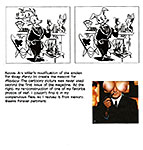
xx.jpg)
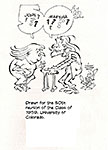
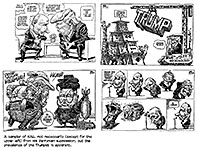
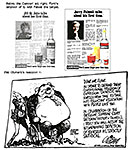
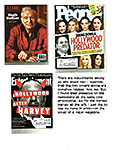
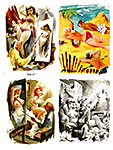
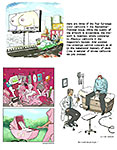
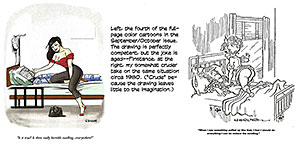
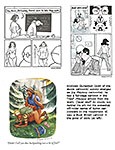
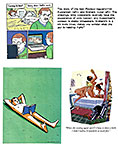
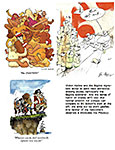
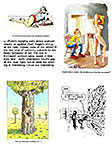
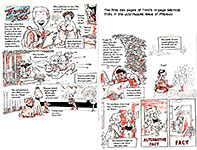
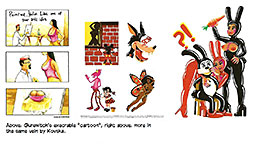
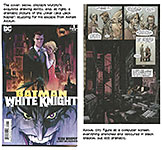
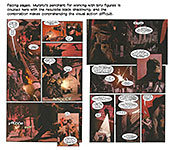
1.jpg)
2.jpg)
3.jpg)
4.jpg)
5.jpg)
6.jpg)
